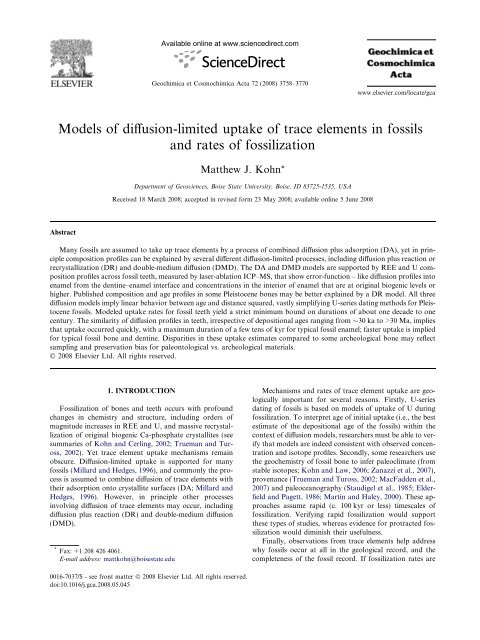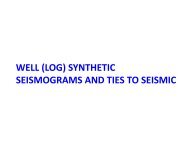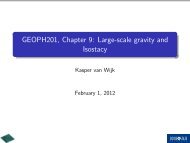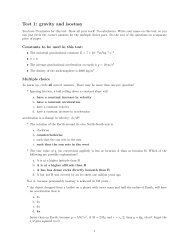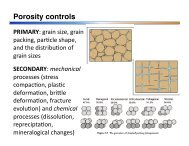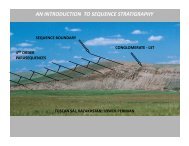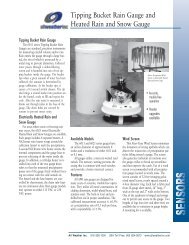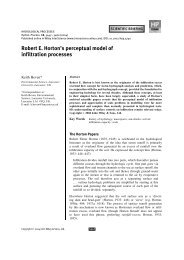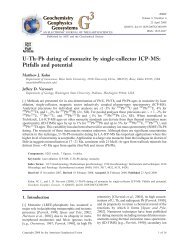Models of diffusion-limited uptake of trace elements in fossils and ...
Models of diffusion-limited uptake of trace elements in fossils and ...
Models of diffusion-limited uptake of trace elements in fossils and ...
You also want an ePaper? Increase the reach of your titles
YUMPU automatically turns print PDFs into web optimized ePapers that Google loves.
Available onl<strong>in</strong>e at www.sciencedirect.com<br />
Geochimica et Cosmochimica Acta 72 (2008) 3758–3770<br />
www.elsevier.com/locate/gca<br />
<strong>Models</strong> <strong>of</strong> <strong>diffusion</strong>-<strong>limited</strong> <strong>uptake</strong> <strong>of</strong> <strong>trace</strong> <strong>elements</strong> <strong>in</strong> <strong>fossils</strong><br />
<strong>and</strong> rates <strong>of</strong> fossilization<br />
Matthew J. Kohn *<br />
Department <strong>of</strong> Geosciences, Boise State University, Boise, ID 83725-1535, USA<br />
Received 18 March 2008; accepted <strong>in</strong> revised form 23 May 2008; available onl<strong>in</strong>e 5 June 2008<br />
Abstract<br />
Many <strong>fossils</strong> are assumed to take up <strong>trace</strong> <strong>elements</strong> by a process <strong>of</strong> comb<strong>in</strong>ed <strong>diffusion</strong> plus adsorption (DA), yet <strong>in</strong> pr<strong>in</strong>ciple<br />
composition pr<strong>of</strong>iles can be expla<strong>in</strong>ed by several different <strong>diffusion</strong>-<strong>limited</strong> processes, <strong>in</strong>clud<strong>in</strong>g <strong>diffusion</strong> plus reaction or<br />
recrystallization (DR) <strong>and</strong> double-medium <strong>diffusion</strong> (DMD). The DA <strong>and</strong> DMD models are supported by REE <strong>and</strong> U composition<br />
pr<strong>of</strong>iles across fossil teeth, measured by laser-ablation ICP–MS, that show error-function – like <strong>diffusion</strong> pr<strong>of</strong>iles <strong>in</strong>to<br />
enamel from the dent<strong>in</strong>e–enamel <strong>in</strong>terface <strong>and</strong> concentrations <strong>in</strong> the <strong>in</strong>terior <strong>of</strong> enamel that are at orig<strong>in</strong>al biogenic levels or<br />
higher. Published composition <strong>and</strong> age pr<strong>of</strong>iles <strong>in</strong> some Pleistocene bones may be better expla<strong>in</strong>ed by a DR model. All three<br />
<strong>diffusion</strong> models imply l<strong>in</strong>ear behavior between age <strong>and</strong> distance squared, vastly simplify<strong>in</strong>g U-series dat<strong>in</strong>g methods for Pleistocene<br />
<strong>fossils</strong>. Modeled <strong>uptake</strong> rates for fossil teeth yield a strict m<strong>in</strong>imum bound on durations <strong>of</strong> about one decade to one<br />
century. The similarity <strong>of</strong> <strong>diffusion</strong> pr<strong>of</strong>iles <strong>in</strong> teeth, irrespective <strong>of</strong> depositional ages rang<strong>in</strong>g from 30 ka to >30 Ma, implies<br />
that <strong>uptake</strong> occurred quickly, with a maximum duration <strong>of</strong> a few tens <strong>of</strong> kyr for typical fossil enamel; faster <strong>uptake</strong> is implied<br />
for typical fossil bone <strong>and</strong> dent<strong>in</strong>e. Disparities <strong>in</strong> these <strong>uptake</strong> estimates compared to some archeological bone may reflect<br />
sampl<strong>in</strong>g <strong>and</strong> preservation bias for paleontological vs. archeological materials.<br />
Ó 2008 Elsevier Ltd. All rights reserved.<br />
1. INTRODUCTION<br />
Fossilization <strong>of</strong> bones <strong>and</strong> teeth occurs with pr<strong>of</strong>ound<br />
changes <strong>in</strong> chemistry <strong>and</strong> structure, <strong>in</strong>clud<strong>in</strong>g orders <strong>of</strong><br />
magnitude <strong>in</strong>creases <strong>in</strong> REE <strong>and</strong> U, <strong>and</strong> massive recrystallization<br />
<strong>of</strong> orig<strong>in</strong>al biogenic Ca-phosphate crystallites (see<br />
summaries <strong>of</strong> Kohn <strong>and</strong> Cerl<strong>in</strong>g, 2002; Trueman <strong>and</strong> Tuross,<br />
2002). Yet <strong>trace</strong> element <strong>uptake</strong> mechanisms rema<strong>in</strong><br />
obscure. Diffusion-<strong>limited</strong> <strong>uptake</strong> is supported for many<br />
<strong>fossils</strong> (Millard <strong>and</strong> Hedges, 1996), <strong>and</strong> commonly the process<br />
is assumed to comb<strong>in</strong>e <strong>diffusion</strong> <strong>of</strong> <strong>trace</strong> <strong>elements</strong> with<br />
their adsorption onto crystallite surfaces (DA; Millard <strong>and</strong><br />
Hedges, 1996). However, <strong>in</strong> pr<strong>in</strong>ciple other processes<br />
<strong>in</strong>volv<strong>in</strong>g <strong>diffusion</strong> <strong>of</strong> <strong>trace</strong> <strong>elements</strong> may occur, <strong>in</strong>clud<strong>in</strong>g<br />
<strong>diffusion</strong> plus reaction (DR) <strong>and</strong> double-medium <strong>diffusion</strong><br />
(DMD).<br />
* Fax: +1 208 426 4061.<br />
E-mail address: mattkohn@boisestate.edu<br />
Mechanisms <strong>and</strong> rates <strong>of</strong> <strong>trace</strong> element <strong>uptake</strong> are geologically<br />
important for several reasons. Firstly, U-series<br />
dat<strong>in</strong>g <strong>of</strong> <strong>fossils</strong> is based on models <strong>of</strong> <strong>uptake</strong> <strong>of</strong> U dur<strong>in</strong>g<br />
fossilization. To <strong>in</strong>terpret age <strong>of</strong> <strong>in</strong>itial <strong>uptake</strong> (i.e., the best<br />
estimate <strong>of</strong> the depositional age <strong>of</strong> the <strong>fossils</strong>) with<strong>in</strong> the<br />
context <strong>of</strong> <strong>diffusion</strong> models, researchers must be able to verify<br />
that models are <strong>in</strong>deed consistent with observed concentration<br />
<strong>and</strong> isotope pr<strong>of</strong>iles. Secondly, some researchers use<br />
the geochemistry <strong>of</strong> fossil bone to <strong>in</strong>fer paleoclimate (from<br />
stable isotopes; Kohn <strong>and</strong> Law, 2006; Zanazzi et al., 2007),<br />
provenance (Trueman <strong>and</strong> Tuross, 2002; MacFadden et al.,<br />
2007) <strong>and</strong> paleoceanography (Staudigel et al., 1985; Elderfield<br />
<strong>and</strong> Pagett, 1986; Mart<strong>in</strong> <strong>and</strong> Haley, 2000). These approaches<br />
assume rapid (c. 100 kyr or less) timescales <strong>of</strong><br />
fossilization. Verify<strong>in</strong>g rapid fossilization would support<br />
these types <strong>of</strong> studies, whereas evidence for protracted fossilization<br />
would dim<strong>in</strong>ish their usefulness.<br />
F<strong>in</strong>ally, observations from <strong>trace</strong> <strong>elements</strong> help address<br />
why <strong>fossils</strong> occur at all <strong>in</strong> the geological record, <strong>and</strong> the<br />
completeness <strong>of</strong> the fossil record. If fossilization rates are<br />
0016-7037/$ - see front matter Ó 2008 Elsevier Ltd. All rights reserved.<br />
doi:10.1016/j.gca.2008.05.045
Trace element <strong>uptake</strong> <strong>in</strong> <strong>fossils</strong>? 3759<br />
too slow, all biogenic materials will degrade before they are<br />
preserved, which contrasts with the observed occurrence <strong>of</strong><br />
<strong>fossils</strong>. Conversely, if rates are too fast, all materials will be<br />
preserved, which contrasts with an <strong>in</strong>complete fossil record.<br />
Yet quantify<strong>in</strong>g ‘‘fast” vs. ‘‘slow” has proved surpris<strong>in</strong>gly<br />
difficult. Preservation <strong>of</strong> s<strong>of</strong>t materials under extraord<strong>in</strong>ary<br />
conditions has been proposed to require weeks (Briggs <strong>and</strong><br />
Kear, 1993). In contrast, U-series dat<strong>in</strong>g <strong>of</strong> bone suggests<br />
timescales <strong>of</strong> many tens <strong>of</strong> kyr for Pleistocene samples<br />
(e.g., Pike et al., 2005), although some bones degrade <strong>in</strong><br />
soils <strong>in</strong> years or decades (Trueman et al., 2004). Diffusion<br />
pr<strong>of</strong>iles, such as discussed here, <strong>and</strong> U-series dat<strong>in</strong>g <strong>of</strong> Pleistocene<br />
materials can be used to <strong>in</strong>fer rates <strong>of</strong> fossilization,<br />
although <strong>in</strong> some cases, only limits are provided.<br />
In this paper, various <strong>diffusion</strong> models are first developed<br />
theoretically to provide a broad mathematical framework<br />
for <strong>in</strong>terpret<strong>in</strong>g <strong>trace</strong> element data. These models are<br />
considered <strong>in</strong> terms <strong>of</strong> age distributions because their largest<br />
impact is likely on age determ<strong>in</strong>ation from geologically<br />
young materials via U-series dat<strong>in</strong>g. Second, new data are<br />
presented for fossil teeth rang<strong>in</strong>g <strong>in</strong> age from 28 ka to<br />
>30 Ma, show<strong>in</strong>g DA <strong>and</strong> likely DMD <strong>in</strong> fossil enamel. F<strong>in</strong>ally,<br />
rates <strong>and</strong> mechanisms <strong>of</strong> fossilization are considered<br />
for typical <strong>fossils</strong> <strong>and</strong> Pleistocene samples that exhibit pr<strong>of</strong>iles<br />
<strong>in</strong> <strong>trace</strong> <strong>elements</strong> that are consistent with a DA model,<br />
or U-series ages that are most consistent with a DR model.<br />
2. WHAT IS ‘‘FOSSILIZATION?’’<br />
The term ‘‘fossilization” is not strictly def<strong>in</strong>ed, but field<br />
identification <strong>of</strong> <strong>fossils</strong> is generally based on lithologic<br />
associations <strong>in</strong>clud<strong>in</strong>g age, qualitative measures <strong>of</strong> density/organic<br />
content, <strong>and</strong> color (commonly dark sta<strong>in</strong>ed);<br />
carbonate fluor-apatite (francolite) dom<strong>in</strong>ates the m<strong>in</strong>eralogy<br />
<strong>of</strong> most fossil bones <strong>and</strong> teeth. Textural <strong>and</strong> m<strong>in</strong>eralogical<br />
features <strong>of</strong> <strong>fossils</strong> <strong>in</strong> turn reflect three major processes:<br />
degradation <strong>of</strong> <strong>in</strong>terstitial organic matter, precipitation <strong>of</strong><br />
dark <strong>in</strong>terstitial oxides <strong>and</strong> oxyhydroxides, <strong>and</strong> <strong>uptake</strong> <strong>of</strong><br />
<strong>trace</strong> <strong>elements</strong>. For this discussion, (compositional) alteration<br />
<strong>and</strong> <strong>trace</strong> element <strong>uptake</strong> are used synonymously,<br />
<strong>and</strong> generally refer to the change <strong>in</strong> chemistry <strong>of</strong> a fossil relative<br />
to its orig<strong>in</strong>al biogenic precursor, as typically reflected<br />
by the <strong>in</strong>crease <strong>in</strong> concentrations <strong>of</strong> F, REE <strong>and</strong> U (e.g.,<br />
2<br />
Trueman <strong>and</strong> Tuross, 2002) <strong>and</strong> loss <strong>of</strong> CO 3<br />
(Wright<br />
<strong>and</strong> Schwarcz, 1996). Fossilization <strong>of</strong> bones <strong>and</strong> some parts<br />
<strong>of</strong> teeth also is commonly accompanied by a fourth major<br />
process – massive crystal coarsen<strong>in</strong>g/recrystallization (Ayliffe<br />
et al., 1994), presumably because <strong>of</strong> Ostwald ripen<strong>in</strong>g<br />
<strong>and</strong>/or dissolution-reprecipitation.<br />
In general all four processes – prote<strong>in</strong> degradation, secondary<br />
m<strong>in</strong>eral precipitation, <strong>trace</strong> element <strong>uptake</strong>/alteration,<br />
<strong>and</strong> recrystallization – are viewed as common<br />
constituents <strong>of</strong> fossilization <strong>and</strong> as proceed<strong>in</strong>g simultaneously,<br />
ma<strong>in</strong>ly for thermodynamic, k<strong>in</strong>etic <strong>and</strong> surface<br />
energetic reasons (Kohn <strong>and</strong> Law, 2006). In brief, bone<br />
<strong>and</strong> dent<strong>in</strong>e crystallites are physically <strong>and</strong> chemically unstable<br />
outside their collagen (prote<strong>in</strong>) matrices. For example<br />
an isolated crystallite <strong>of</strong> bone apatite exposes approximately<br />
50% <strong>of</strong> its atoms on its surface (Eppell et al.,<br />
2001), <strong>and</strong> solubility <strong>of</strong> prist<strong>in</strong>e biogenic apatite may be<br />
5–10 orders <strong>of</strong> magnitude higher than its F-rich, CO 3 2 -<br />
poor fossil counterpart (Elliott, 2002; Rakovan, 2002; Berna<br />
et al., 2004; see also Driessens <strong>and</strong> Verbeeck, 1990). The<br />
absence <strong>of</strong> significant OH <strong>in</strong> the hydroxyl site <strong>of</strong> modern<br />
bone apatite probably enhances its solubility greatly compared<br />
to stable geological hydroxyl- or fluor-apatites (Berna<br />
et al., 2004; Pasteris et al., 2004). Thus, degradation <strong>of</strong><br />
organic matter must either promote crystallite dissolution<br />
or, if a fossil is to be preserved, recrystallization <strong>and</strong> chemical<br />
alteration.<br />
High porosities <strong>and</strong> permeabilities <strong>in</strong> modern bone <strong>and</strong><br />
dent<strong>in</strong>e along pores, tubules, <strong>and</strong> crystallite-prote<strong>in</strong> <strong>in</strong>terfaces<br />
promote rapid transport <strong>of</strong> material, both <strong>in</strong>gress <strong>of</strong><br />
<strong>trace</strong> <strong>elements</strong> from surround<strong>in</strong>g soils <strong>and</strong> soil waters,<br />
<strong>and</strong> egress <strong>of</strong> degraded organic matter. Yet, coarsen<strong>in</strong>g <strong>of</strong><br />
crystallites, loss <strong>of</strong> organic constituents, <strong>and</strong> block<strong>in</strong>g <strong>of</strong><br />
pore spaces with secondary m<strong>in</strong>erals must ultimately limit<br />
<strong>and</strong> even shut down this process. That is, <strong>in</strong>itial fossilization<br />
must promote marked resistance to further chemical<br />
<strong>and</strong> physical alteration. Trace element ‘‘f<strong>in</strong>gerpr<strong>in</strong>ts,” <strong>in</strong><br />
the form <strong>of</strong> dist<strong>in</strong>ctive REE patterns or <strong>trace</strong> element ratios,<br />
are preserved <strong>in</strong> <strong>fossils</strong> over millions <strong>of</strong> years <strong>and</strong> support<br />
this view (see Trueman <strong>and</strong> Tuross, 2002), although<br />
outer surfaces <strong>of</strong> <strong>fossils</strong> may be affected by aerial exposure,<br />
<strong>and</strong> undergo dissolution <strong>and</strong>/or chemical alteration (e.g., U<br />
solubilities are quite dependent <strong>of</strong> f O2 ). Thus, external surfaces<br />
could develop compositional complexities due to<br />
chang<strong>in</strong>g boundary conditions after fossilization, but <strong>in</strong>teriors<br />
<strong>and</strong> <strong>in</strong>ternal boundaries such as bone–dent<strong>in</strong>e or dent<strong>in</strong>e–enamel<br />
are expected to present chemically <strong>and</strong><br />
<strong>in</strong>terpretationally simpler systems: they are less susceptible<br />
to later <strong>uptake</strong>/alteration, so they preserve compositions<br />
reflective <strong>of</strong> <strong>in</strong>itial fossilization. This view is supported by<br />
comparable <strong>trace</strong> element pr<strong>of</strong>iles <strong>in</strong> enamel next to dent<strong>in</strong>e<br />
from fossil teeth that differ <strong>in</strong> age by 3 orders <strong>of</strong> magnitude<br />
(this study).<br />
Focus<strong>in</strong>g on cation chemistry, modern biogenic phosphates<br />
have quite low concentrations <strong>of</strong> REE <strong>and</strong> U (c.<br />
10 ppb or less; Kohn et al., 1999). In contrast, many fossil<br />
bones exhibit high U <strong>and</strong> REE contents (up to 100s <strong>of</strong> ppm;<br />
see Trueman <strong>and</strong> Tuross, 2002). Uranium concentrations<br />
can be quite homogeneous on scales <strong>of</strong> mm’s (e.g., Millard<br />
<strong>and</strong> Hedges, 1996; Janssens et al., 1999; Pike et al., 2005),<br />
whereas gradients <strong>in</strong> REE have sometimes been observed,<br />
e.g., samples from Olduvai Gorge (Henderson et al.,<br />
1983; Williams et al., 1997; Janssens et al., 1999; Trueman<br />
et al., 2006). Compositional gradients on bone edges contrast<br />
with homogeneous REE <strong>and</strong> U <strong>in</strong> the <strong>in</strong>terior <strong>of</strong> some<br />
<strong>of</strong> these same samples (Janssens et al., 1999), <strong>and</strong> together<br />
these data imply compositional homogenization dur<strong>in</strong>g <strong>in</strong>itial<br />
fossilization, with some susceptibility to overpr<strong>in</strong>t<strong>in</strong>g on<br />
surfaces either dur<strong>in</strong>g the late stages <strong>of</strong> fossilization, or perhaps<br />
after fossilization. Note that <strong>uptake</strong> <strong>of</strong> U millions <strong>of</strong><br />
years after deposition is also implied <strong>in</strong> the age systematics<br />
<strong>of</strong> some materials (e.g., see Peppe <strong>and</strong> Re<strong>in</strong>ers, 2007),<br />
although the location <strong>of</strong> this ‘‘young” U is not well documented.<br />
High U concentrations have <strong>in</strong>spired numerous<br />
U-series chronologic <strong>in</strong>vestigations, <strong>and</strong> several studies<br />
demonstrate older U-series ages towards the external <strong>and</strong><br />
<strong>in</strong>ternal surfaces <strong>of</strong> cortical bone relative to its <strong>in</strong>terior
3760 M.J. Kohn / Geochimica et Cosmochimica Acta 72 (2008) 3758–3770<br />
(e.g., see Millard <strong>and</strong> Hedges, 1996; Pike et al., 2001, 2005).<br />
These ages <strong>in</strong>dicate that U is first taken up <strong>in</strong> bone at its<br />
<strong>in</strong>terface with sediment or fluid, <strong>and</strong> preferentially immobilized<br />
via adsorption <strong>and</strong>/or recrystallization.<br />
Fossil teeth have received less attention, but dent<strong>in</strong>e<br />
shows close similarities to bone <strong>in</strong> its physical <strong>and</strong> isotopic<br />
response to fossilization (Ayliffe et al., 1994; Kohn <strong>and</strong><br />
Law, 2006) <strong>and</strong> one previous study revealed uniformly high<br />
U concentrations (several tens <strong>of</strong> ppm) across fossil dent<strong>in</strong>e<br />
(Egg<strong>in</strong>s et al., 2003). Enamel appears quite resistant to<br />
alteration <strong>of</strong> stable O <strong>and</strong> C isotopes (Kohn <strong>and</strong> Cerl<strong>in</strong>g,<br />
2002), presumably because coarse crystallites resist recrystallization<br />
(Ayliffe et al., 1994); its <strong>trace</strong> element chemistry,<br />
however, can be radically altered (Kohn et al., 1999). The<br />
mechanisms for <strong>trace</strong> element <strong>uptake</strong> <strong>in</strong> enamel are unclear,<br />
but <strong>in</strong> the absence <strong>of</strong> recrystallization, some form <strong>of</strong><br />
adsorption or <strong>in</strong>tracrystall<strong>in</strong>e <strong>diffusion</strong> would appear<br />
important. One previous study has shown steep concentration<br />
gradients <strong>in</strong> enamel adjacent to dent<strong>in</strong>e (Egg<strong>in</strong>s et al.,<br />
2003), but the numerical consistency <strong>of</strong> these gradients with<br />
<strong>diffusion</strong> was not explored.<br />
3. DIFFUSION MODELS<br />
Mechanistically, three endmember models <strong>of</strong> diffusive<br />
<strong>uptake</strong> may be considered: <strong>diffusion</strong>–adsorption (DA), <strong>diffusion</strong>-reaction<br />
(DR) <strong>and</strong> double-medium <strong>diffusion</strong> (DMD;<br />
Fig. 1). These models mutually differ both <strong>in</strong> physical<br />
behavior <strong>and</strong> mathematical treatment. Emphasis is placed<br />
here on bone, both because <strong>of</strong> its historical importance <strong>in</strong><br />
U-series dat<strong>in</strong>g <strong>of</strong> archeological materials, <strong>and</strong> because<br />
the most comprehensive <strong>diffusion</strong> model (DA) was developed<br />
for this material (Millard <strong>and</strong> Hedges, 1996).<br />
3.1. Conceptual description<br />
Trace element <strong>uptake</strong> <strong>in</strong> Pleistocene bone is commonly<br />
modeled by DA (Millard <strong>and</strong> Hedges, 1996), <strong>in</strong> which <strong>trace</strong><br />
<strong>elements</strong> simultaneously diffuse through the bone matrix,<br />
<strong>and</strong> are immobilized by adsorption onto bioapatite crystal<br />
surfaces (Fig. 1A). The DA model expla<strong>in</strong>s systematic decreases<br />
<strong>in</strong> <strong>trace</strong> element concentration towards the <strong>in</strong>teriors<br />
<strong>of</strong> some fossil bone, <strong>and</strong> REE partition coefficients putatively<br />
more consistent with adsorption rather than <strong>in</strong>tracrystall<strong>in</strong>e<br />
equilibrium (Koeppenkastrop <strong>and</strong> De Carlo,<br />
1992). However, although DA models are commonly used<br />
<strong>in</strong> <strong>in</strong>terpret<strong>in</strong>g U-series ages <strong>in</strong> bone, they conflict with observed<br />
recrystallization <strong>and</strong> gra<strong>in</strong>-size coarsen<strong>in</strong>g <strong>in</strong> fossil<br />
bone <strong>and</strong> dent<strong>in</strong>e (Ayliffe et al., 1994). Instead, DA is conceptually<br />
most applicable to enamel, where gra<strong>in</strong> sizes do<br />
not appreciably <strong>in</strong>crease dur<strong>in</strong>g fossilization.<br />
DR describes better the recrystallization <strong>and</strong> gra<strong>in</strong>-size<br />
coarsen<strong>in</strong>g observed <strong>in</strong> many <strong>fossils</strong>, <strong>and</strong> the expected concomitant<br />
immobilization <strong>of</strong> <strong>trace</strong> <strong>elements</strong> (Fig. 1B). For<br />
short times, however, the DR model predicts an abrupt<br />
chemical front that is not matched by some Pleistocene<br />
materials.<br />
The DMD model assumes that fast-<strong>diffusion</strong> pathways<br />
bound doma<strong>in</strong>s exhibit<strong>in</strong>g slow-<strong>diffusion</strong> rates (Watson,<br />
1991; Wang, 1993; Fig. 1C); DMD is identified experimentally<br />
from relatively high-concentration ‘‘tails” on <strong>diffusion</strong><br />
pr<strong>of</strong>iles far <strong>in</strong> the <strong>in</strong>terior <strong>of</strong> a medium compared to the expected<br />
pr<strong>of</strong>ile from a s<strong>in</strong>gle medium diffusive model. For<br />
example, Fig. 1C shows the expected pr<strong>of</strong>ile for a simple<br />
DA model (dashed l<strong>in</strong>e), <strong>and</strong> the higher than expected concentrations<br />
far from the boundary that are supported by<br />
the second, fast-<strong>diffusion</strong> pathway. These tails are dist<strong>in</strong>ct<br />
from <strong>diffusion</strong> pr<strong>of</strong>iles predicted for penetration from two<br />
sides <strong>of</strong> a material, e.g., simultaneously from the <strong>in</strong>ternal<br />
<strong>and</strong> external surfaces <strong>of</strong> cortical or compact bone. DMD<br />
is consistent with nm-scale apatite crystallites <strong>and</strong> lm-scale<br />
bundles (presumed slow-<strong>diffusion</strong> doma<strong>in</strong>s) separated by<br />
<strong>in</strong>terstitial pores <strong>and</strong> organic complexes (presumed fast-<strong>diffusion</strong><br />
pathways). Although <strong>in</strong>tracrystall<strong>in</strong>e <strong>diffusion</strong> rates<br />
<strong>in</strong> apatite (e.g., Cherniak, 2000) might appear too sluggish<br />
to permit significant <strong>uptake</strong> by volume <strong>diffusion</strong>, <strong>in</strong>validat-<br />
A B C<br />
DA<br />
DR<br />
DMD<br />
Solid + fluid<br />
C<br />
x<br />
C<br />
Reacted<br />
Solid<br />
Unreacted<br />
Solid<br />
x<br />
C<br />
DA<br />
pr<strong>of</strong>ile<br />
DMD<br />
pr<strong>of</strong>ile<br />
x<br />
Fig. 1. Schematic <strong>of</strong> <strong>diffusion</strong> models <strong>and</strong> correspond<strong>in</strong>g <strong>trace</strong> element pr<strong>of</strong>iles for short timescales. (A) Diffusion–adsorption, show<strong>in</strong>g simple<br />
error-function pr<strong>of</strong>ile. (B) Diffusion-reaction, show<strong>in</strong>g step <strong>in</strong> concentration between recrystallized <strong>and</strong> unrecrystallized material. Dashed l<strong>in</strong>e<br />
shows contribution <strong>of</strong> <strong>in</strong>terstitial fluid. (C) Double-medium Diffusion, show<strong>in</strong>g two separate error-function—like pr<strong>of</strong>iles, represent<strong>in</strong>g the<br />
two different <strong>diffusion</strong> pathways. Dashed l<strong>in</strong>e is schematic result for DA model.
Trace element <strong>uptake</strong> <strong>in</strong> <strong>fossils</strong>? 3761<br />
<strong>in</strong>g DMD, faster <strong>diffusion</strong> rates have been documented for<br />
some <strong>elements</strong> <strong>in</strong> the near surface (outer few nm) <strong>of</strong> calcite<br />
crystals (Stipp et al., 1992). Because the bioapatite that<br />
composes <strong>fossils</strong> is nanocrystall<strong>in</strong>e, even after fossilization,<br />
relatively fast <strong>in</strong>tracrystall<strong>in</strong>e <strong>diffusion</strong> may permit DMD.<br />
Given sufficient time, all three models can expla<strong>in</strong> homogeneous<br />
compositions documented <strong>in</strong> some <strong>fossils</strong>, <strong>and</strong> all<br />
three processes might occur simultaneously. The central<br />
po<strong>in</strong>ts <strong>of</strong> the follow<strong>in</strong>g discussion are to demonstrate that<br />
(1) the exact fossilization process is irrelevant to dat<strong>in</strong>g<br />
problems, as long as boundaries were simple <strong>and</strong> <strong>trace</strong> element<br />
<strong>uptake</strong> was <strong>limited</strong> by <strong>diffusion</strong>, <strong>and</strong> (2) appropriate<br />
mathematical treatment <strong>of</strong> data simplifies <strong>in</strong>terpretation<br />
<strong>and</strong> error analysis.<br />
3.2. Mathematic treatment<br />
All solutions to the <strong>diffusion</strong> equation can be expressed<br />
<strong>in</strong> terms <strong>of</strong> the dimensionless variables reduced time (t 0 ) <strong>and</strong><br />
reduced distance squared (X 02 ). For this paper, t 0 = D eff t/l 2<br />
<strong>and</strong> X 0 = X/l, where D eff is the effective <strong>diffusion</strong> coefficient,<br />
t is time, l is the half-width <strong>of</strong> the tissue considered, <strong>and</strong> X is<br />
distance. Some workers prefer t 0 =[D eff t/l 2 ] 1/2 . The effective<br />
<strong>diffusion</strong> coefficient (D eff ) is the ratio <strong>of</strong> the <strong>trace</strong>r <strong>diffusion</strong><br />
rate (D) <strong>in</strong> a fluid <strong>and</strong> the partition coefficient between biogenic<br />
apatite <strong>and</strong> diagenetic or pedogenic fluids (K d ), corrected<br />
for porosity (r) <strong>and</strong> tortuosity (s), i.e., D eff = Dr/<br />
K d s 2 . Note that <strong>in</strong> applications discussed below D eff is a<br />
measured value, so it automatically accounts for contributions<br />
from porosity <strong>and</strong> tortuosity, <strong>and</strong> that K d , r, <strong>and</strong> s<br />
are presumed constant, so solutions to the <strong>diffusion</strong> equation<br />
scale equivalently with either D or D eff . If material diffuses<br />
from a s<strong>in</strong>gle (planar) boundary, e.g., from dent<strong>in</strong>e<br />
<strong>in</strong>to enamel across the dent<strong>in</strong>e–enamel <strong>in</strong>terface, <strong>and</strong>/or<br />
<strong>diffusion</strong> pr<strong>of</strong>iles are short (t 0 is small) then a semi-<strong>in</strong>f<strong>in</strong>ite<br />
solution is used, <strong>and</strong> X 0 is expressed as the distance from<br />
that surface or boundary (where X 0 = 0). In contrast, if<br />
material diffuses between 2 parallel <strong>in</strong>terfaces, e.g., <strong>in</strong>ward<br />
from both the <strong>in</strong>terior <strong>and</strong> exterior surfaces <strong>of</strong> cortical<br />
bone, then a plane sheet solution is used, <strong>and</strong> X 0 is expressed<br />
as the distance from the midpo<strong>in</strong>t between the<br />
two boundaries: X 0 = 0 is the center <strong>of</strong> the sheet, <strong>and</strong><br />
X 0 =1, 1 are the boundaries.<br />
Most models assume a fixed boundary condition, i.e.,<br />
that the concentration at any bound<strong>in</strong>g surface (C o ) is fixed<br />
at time t = 0. The <strong>in</strong>itial concentration <strong>of</strong> the diffus<strong>in</strong>g species<br />
(e.g., U, REE etc.) <strong>in</strong> the fossiliz<strong>in</strong>g tissue is also commonly<br />
assumed to be zero, <strong>and</strong> although this assumption is<br />
not required, it closely approximates biogenic compositions<br />
(e.g., see Driessens <strong>and</strong> Verbeeck, 1990; Kohn et al., 1999).<br />
Mathematically all models predict the change <strong>in</strong> <strong>trace</strong> element<br />
concentration (C), or its normalized concentration,<br />
(C 0 , where C 0 = C/C o ), as a function <strong>of</strong> reduced distance<br />
(X 0 ) <strong>and</strong> reduced time (t 0 ). Solutions to the <strong>diffusion</strong> equation<br />
were obta<strong>in</strong>ed from Crank (1975), specifically Eqs.<br />
3.13 (semi-<strong>in</strong>f<strong>in</strong>ite medium solution for model<strong>in</strong>g short <strong>diffusion</strong><br />
pr<strong>of</strong>iles <strong>in</strong> enamel), either 2.54 or 2.68 (plane sheet<br />
solutions for model<strong>in</strong>g long <strong>diffusion</strong> pr<strong>of</strong>iles <strong>in</strong> bone),<br />
<strong>and</strong> 13.13 plus 13.18 (semi-<strong>in</strong>f<strong>in</strong>ite medium solution for<br />
model<strong>in</strong>g DR).<br />
In this discussion, the term t 0 Dep is used to describe the<br />
time s<strong>in</strong>ce <strong>in</strong>itiation <strong>of</strong> the boundary condition <strong>and</strong> is equivalent<br />
to the total duration, or t 0 , <strong>of</strong> a model. In practice,<br />
t 0 Dep is proportional to the true depositional age, with a<br />
proportionality constant <strong>of</strong> D eff /l 2 . The term t 0 app is used<br />
to describe the apparent age at position X 0 with<strong>in</strong> a sample.<br />
In practice, t 0 app is proportional to the measured age with<br />
the same proportionality constant, D eff /l 2 .<br />
Examples for the DA plane sheet model show <strong>in</strong>creases<br />
<strong>in</strong> <strong>trace</strong> element concentration over time, with the rate <strong>of</strong><br />
<strong>in</strong>crease dependent on distance from the boundaries <strong>and</strong><br />
time (Fig. 2A). These concentration pr<strong>of</strong>iles must be converted<br />
to an age. For short <strong>diffusion</strong> pr<strong>of</strong>iles, e.g., REE <strong>in</strong><br />
enamel, this may be accomplished by fitt<strong>in</strong>g an <strong>in</strong>verse<br />
C/Co<br />
1.0<br />
0.8<br />
0.6<br />
0.4<br />
0.2<br />
X’=0.9<br />
X’=0.7<br />
X’=0.5<br />
X’=0.3<br />
X’=0.1<br />
t' app =<br />
t' True<br />
∫<br />
[ C/C o ]dt'<br />
t'=0<br />
t' Dep<br />
t'app<br />
1.0<br />
0.8<br />
0.6<br />
0.4<br />
0.2<br />
0.0<br />
0.0<br />
0.5<br />
0.0 0.2 0.4 0.6 0.8 1.0 0.0 0.2 0.4 0.6 0.8 1.0<br />
0.0 0.2 0.4 0.6 0.8 1.0<br />
t' Dep t' Dep Edge Distance<br />
X’=1.0<br />
X’=0.9<br />
X’=0.7<br />
X’=0.5<br />
X’=0.3<br />
X’=0.1<br />
Figure<br />
2C<br />
A B C<br />
t'app<br />
1.0<br />
0.9<br />
0.8<br />
0.7<br />
0.6<br />
1-X'<br />
1-X' 2<br />
t' Dep = 1.0<br />
Fig. 2. Numerical results <strong>of</strong> plane sheet DA model for U <strong>uptake</strong> over a range <strong>of</strong> timescales. (A) Concentration vs. time for different distances.<br />
Boundary is at X 0 = 1, <strong>and</strong> has constant composition C o throughout. Apparent age is determ<strong>in</strong>ed by <strong>in</strong>tegrat<strong>in</strong>g concentration curve (<strong>in</strong> terms<br />
<strong>of</strong> C/C o ) at a particular value <strong>of</strong> X 0 over duration t 0 Dep , <strong>and</strong> ratio<strong>in</strong>g to t0 Dep . (B) Apparent age ðt0 app Þ vs. depositional age ðt0 Dep<br />
, or age <strong>of</strong> <strong>in</strong>itial<br />
establishment <strong>of</strong> fixed boundary condition). At boundary (X 0 = 1) apparent <strong>and</strong> depositional ages co<strong>in</strong>cide, so the slope is 1. For long times,<br />
the slope <strong>of</strong> t 0 app<br />
for all positions approaches 1 as U is saturated. Circle shows <strong>in</strong>tegrated composition correspond<strong>in</strong>g to gray region <strong>in</strong> Fig. 2A.<br />
Box shows data po<strong>in</strong>ts plotted <strong>in</strong> Fig. 2C. (C) t 0 app<br />
vs. distance, show<strong>in</strong>g quadratic form with respect to distance, <strong>and</strong> l<strong>in</strong>earity with respect to<br />
distance squared. Note that any function that is l<strong>in</strong>ear <strong>in</strong> X 02 is also l<strong>in</strong>ear <strong>in</strong> 1 X 02 .<br />
Core
3762 M.J. Kohn / Geochimica et Cosmochimica Acta 72 (2008) 3758–3770<br />
X 0 were regressed assum<strong>in</strong>g l<strong>in</strong>earity with respect to X 02 .<br />
error-function to the observed data. For U-series data,<br />
ically calculated values <strong>of</strong> t 0 app for different values <strong>of</strong> t0 Dep <strong>and</strong> This result applies both to dimensionless time or to actual<br />
however, t 0 app is determ<strong>in</strong>ed by <strong>in</strong>tegrat<strong>in</strong>g U concentration<br />
at that po<strong>in</strong>t over the duration <strong>of</strong> the model (t 0 Dep; Fig. 2A<br />
<strong>and</strong> B). Note that if normalized concentrations are used, C 0<br />
This model is widely applied to <strong>in</strong>terpret U <strong>uptake</strong> <strong>in</strong> fossil<br />
bone (Millard <strong>and</strong> Hedges, 1996), <strong>and</strong> closely approximates<br />
the expression:<br />
at the boundary is 1.0, <strong>and</strong> the <strong>in</strong>tegrated area at X 0 =1is<br />
identically t 0 Dep. These t 0 app ages require that U is immobilized<br />
t 0 app t0 Dep þ 0:5ðe 2:25t0 Dep<br />
1:0Þð1:0 X 02 Þ ð2Þ<br />
upon <strong>uptake</strong>, either by recrystallization (DR), or or equivalently for t (measured age) <strong>and</strong> X (measured<br />
adsorption onto apatite crystallites (DA <strong>and</strong> DMD). In essence,<br />
distance):<br />
any U that accumulates at position X 0 may no longer<br />
diffuse but <strong>in</strong>stead is subject to decay.<br />
t<br />
All three DA, DMD, <strong>and</strong> DR models yield l<strong>in</strong>ear t 0 app t Dep þ 0:5ðe 2:25t Dep 1:0Þðl 2 X 2 Þ<br />
app<br />
D<br />
ð3Þ<br />
distributions with respect to the square <strong>of</strong> the distance<br />
Note that a function that is l<strong>in</strong>ear <strong>in</strong> X 02 must also be l<strong>in</strong>ear<br />
(either X 2 or X ):<br />
<strong>in</strong> (1 X 02 ), <strong>and</strong> that these relationships are least accurate<br />
t 0 app ¼ kX 02 þ b<br />
ð1Þ for short times, where the distribution <strong>of</strong> t 0 app vs. X02 is least<br />
l<strong>in</strong>ear (Fig. 3B). Analogous expressions apply to either <strong>of</strong><br />
where k <strong>and</strong> b are constants. This conclusion is numerically<br />
demonstrated for plane sheet DA models (Figs. 2 <strong>and</strong> 3),<br />
<strong>and</strong> is explicit <strong>in</strong> solutions to the DR model (Crank,<br />
the two segments <strong>of</strong> the DMD model.<br />
For the DR model, assum<strong>in</strong>g <strong>diffusion</strong> through a porous<br />
medium, the relation <strong>in</strong> terms <strong>of</strong> X <strong>and</strong> t is (see Appendix):<br />
1975; see derivation <strong>in</strong> Appendix). Specifically, for the<br />
DR model, concentrations at any po<strong>in</strong>t X 0 are zero, until<br />
X 2 ¼½ðC 1 C x Þ=C x Š½8D eff =pŠt ð4Þ<br />
time t 0 app<br />
, when the front passes this position. Because the<br />
front progresses proportionally to X 02 , so too must t 0 app .<br />
For DMD, both segments are functionally equivalent to<br />
the DA model (Zhang et al., 2006), albeit with different D eff ,<br />
so DMD solutions should yield two different, but l<strong>in</strong>ear segments<br />
on a plot <strong>of</strong> t 0 app vs. X02 , each imply<strong>in</strong>g the same t 0 Dep.<br />
For the plane sheet DA models (Figs. 2 <strong>and</strong> 3), numer-<br />
where C 1 <strong>and</strong> C x are constants that describe compositional<br />
concentrations at the boundary <strong>and</strong> at the recrystalliz<strong>in</strong>g<br />
front, respectively.<br />
Thus, regardless <strong>of</strong> <strong>diffusion</strong> mechanism, ages derived<br />
from U-series or other means can be regressed vs. (reduced)<br />
distance squared to <strong>in</strong>fer the age <strong>of</strong> <strong>in</strong>itial <strong>trace</strong> element <strong>uptake</strong>,<br />
with the slope reflect<strong>in</strong>g other properties, notably D.<br />
1.00<br />
A<br />
t' Dep =1.75<br />
1.75<br />
B<br />
t' app ~ t' Dep + 0.5(e -2.25t' Dep - 1.0)(1-X' 2 )<br />
0.80<br />
t' Dep =1.0<br />
1.50<br />
t' Dep =1.75<br />
t' Dep =0.4<br />
1.25<br />
C/Co<br />
0.60<br />
0.40<br />
0.20<br />
Near-edge<br />
U loss<br />
t' Dep =0.1<br />
= SWC3 [U]<br />
0.00<br />
0.0 0.2 0.4 0.6 0.8 1.0<br />
Edge<br />
1-X' 2<br />
Core<br />
t' app<br />
1.00<br />
0.75<br />
0.50<br />
0.25<br />
t' Dep =1.0<br />
67±9 ka<br />
t' Dep =0.4<br />
t' Dep =0.1<br />
SWC3<br />
U-series<br />
0.00<br />
0.0 0.2 0.4 0.6 0.8 1.0<br />
Edge<br />
1-X' 2<br />
Core<br />
Fig. 3. Normalized plots <strong>of</strong> <strong>trace</strong> element (U) <strong>uptake</strong> <strong>and</strong> age determ<strong>in</strong>ations vs. reduced distance squared for plane sheet DA model (solid<br />
symbols), illustrat<strong>in</strong>g l<strong>in</strong>ear behavior over large range <strong>of</strong> timescales. Natural data (open symbols) are normalized U-series dates from a<br />
Pleistocene bone (Pike et al., 2005). (A) Normalized concentrations. With <strong>in</strong>creas<strong>in</strong>g t 0 Dep<br />
, concentrations become essentially constant across<br />
tissue; steep concentration pr<strong>of</strong>iles are realized only for low values <strong>of</strong> t 0 Dep<br />
. Homogeneous compositions from Pleistocene bone (except<strong>in</strong>g nearedge<br />
U loss) require t 0 Dep P 1. (B) t0 app . Slope steepens between t0 Dep<br />
¼ 0to1.0, as U is taken up <strong>and</strong> develops a chemical <strong>diffusion</strong> pr<strong>of</strong>ile.<br />
For t 0 Dep<br />
> 1:0, U is saturated (concentration pr<strong>of</strong>iles are flat) <strong>and</strong> slope does not change (see Fig. 2B). Data for natural sample SWC3<br />
assume D eff =4 10 14 cm 2 /s; l<strong>in</strong>earity is consistent with diffusive <strong>uptake</strong>, but DA model cannot simultaneously expla<strong>in</strong> steep slope (low t 0 Dep )<br />
<strong>and</strong> homogeneous U across bone (high t 0 Dep<br />
). See text for discussion. Age <strong>and</strong> 95% confidence limits based on weighted least squares<br />
regression. MSWD (or RMSE) = 1.5, suggest<strong>in</strong>g data scatter is largely expla<strong>in</strong>ed by analytical uncerta<strong>in</strong>ties.
Trace element <strong>uptake</strong> <strong>in</strong> <strong>fossils</strong>? 3763<br />
measured ages because t 0 app<br />
<strong>in</strong>volves only measured age<br />
(t app ) <strong>and</strong> two parameters that are both presumed constant<br />
(D <strong>and</strong> l). Note that all models are formulated assum<strong>in</strong>g<br />
that <strong>in</strong>ward <strong>diffusion</strong> <strong>of</strong> U limits <strong>uptake</strong>, but <strong>in</strong> reality <strong>uptake</strong><br />
may <strong>in</strong>stead be <strong>limited</strong> by the breakdown <strong>of</strong> collagen<br />
<strong>and</strong> consequent exposure <strong>of</strong> crystallites. Regardless, if<br />
either collagen breakdown or its outward transport is controlled<br />
by <strong>diffusion</strong>, <strong>and</strong> if <strong>in</strong>terstitial fluids are saturated <strong>in</strong><br />
U, then the same functional dependencies are expected, because<br />
the problem can be viewed as the <strong>in</strong>ward <strong>diffusion</strong> <strong>of</strong><br />
sites available to U <strong>uptake</strong>.<br />
The l<strong>in</strong>earity <strong>of</strong> age with respect to distance squared<br />
vastly simplifies <strong>in</strong>terpretations <strong>of</strong> the tim<strong>in</strong>g <strong>of</strong> <strong>trace</strong> element<br />
<strong>uptake</strong>. Simple l<strong>in</strong>ear regressions <strong>of</strong> measured ages<br />
can be performed, with straightforward assessment <strong>of</strong> quality<br />
<strong>of</strong> fit, <strong>and</strong> propagation <strong>of</strong> errors to determ<strong>in</strong>e age uncerta<strong>in</strong>ties.<br />
Such an approach directly evaluates whether a<br />
dataset is consistent with a <strong>trace</strong> element <strong>uptake</strong> process<br />
that is <strong>limited</strong> by <strong>diffusion</strong>, as non-l<strong>in</strong>ear behavior implies<br />
more complex, potentially non-diffusive processes. Examples<br />
are discussed <strong>in</strong> subsequent sections.<br />
4. DIFFUSION PROFILES IN ENAMEL<br />
4.1. Analytical methods<br />
Samples <strong>of</strong> fossil teeth were collected from strata <strong>in</strong> NW<br />
Nebraska, <strong>and</strong> obta<strong>in</strong>ed on loan from the Idaho Museum<br />
<strong>of</strong> Natural History (IMNH) <strong>and</strong> from Hagerman Fossil<br />
Beds National Monument (HAFO). The Nebraska samples<br />
are 33.2 Ma (Zanazzi et al., 2007), <strong>and</strong> <strong>in</strong>clude a primitive<br />
rabbit (Paleolagus sp.), a small deer-like mammal (Leptomeryx<br />
evansi), <strong>and</strong> a medium-sized primitive artiodactyl<br />
(Leptauchenia sp.); these taxa were chosen because their<br />
tooth enamel thicknesses range from 75 lm (Paleolagus<br />
sp.) to 500 lm(Leptauchenia sp.). The IMNH <strong>and</strong> HAFO<br />
samples are all Equus sp., which have enamel thicknesses up<br />
to 1 mm; the IMNH samples are from the Sangamonian<br />
<strong>in</strong>terglacial (c. 125 ka), <strong>and</strong> from strata 14 C dated to between<br />
22 <strong>and</strong> 33 ka (Jefferson et al., 2002), whereas the<br />
Hagerman samples are 3.2 ± 0.1 Ma (Hart <strong>and</strong> Brueseke,<br />
1999), i.e., from the mid-Pliocene climatic optimum. For<br />
the IMNH <strong>and</strong> HAFO Equus samples, strips <strong>of</strong> enamel plus<br />
dent<strong>in</strong>e, a few mm wide <strong>and</strong> several mm deep were cut<br />
along the length <strong>of</strong> each tooth us<strong>in</strong>g a slow-speed microsaw.<br />
Each strip was subsampled every 1.5 mm, yield<strong>in</strong>g a fragment<br />
<strong>of</strong> enamel plus dent<strong>in</strong>e a few mm 2 <strong>in</strong> area. These fragments<br />
were mounted <strong>in</strong> a 1” epoxy round, <strong>and</strong> polished.<br />
For the Nebraska samples, strips <strong>of</strong> enamel plus dent<strong>in</strong>e<br />
were cut from each fossil <strong>and</strong> mounted <strong>in</strong> epoxy, without<br />
subsampl<strong>in</strong>g.<br />
Analyses were collected by us<strong>in</strong>g a s<strong>in</strong>gle-collector,<br />
<strong>in</strong>ductively coupled plasma, mass spectrometer (ICP–MS),<br />
housed at the GeoAnalytical Laboratory, Wash<strong>in</strong>gton<br />
State University. A frequency qu<strong>in</strong>tupled Nd:YAG laser<br />
(New Wave Research UP-213; k = 213 nm) operat<strong>in</strong>g at<br />
10 J/cm 2 was used to ablate the sample along traverses<br />
8–12 lm wide <strong>and</strong> several mm long (Fig. 4); a He stream<br />
(1.3 l/m<strong>in</strong>) delivered ablated material to the plasma<br />
source <strong>of</strong> a ThermoF<strong>in</strong>nigan Element2 magnetic-sector<br />
Ce, Yb (ppm)<br />
10000<br />
1000<br />
100<br />
10<br />
“<strong>in</strong>” pr<strong>of</strong>ile<br />
“wash-<strong>in</strong>”<br />
Dent<strong>in</strong>e<br />
“<strong>in</strong>”<br />
Enamel<br />
Cerium<br />
Ytterbium<br />
1<br />
Enamel<br />
Dent<strong>in</strong>e<br />
Enamel<br />
0.1<br />
0 100 200 300 400 500 600<br />
Distance (m)<br />
“out” pr<strong>of</strong>ile<br />
Fig. 4. Logarithm <strong>of</strong> concentration vs. distance for <strong>trace</strong> element<br />
pr<strong>of</strong>iles from enamel <strong>in</strong>to dent<strong>in</strong>e (‘‘<strong>in</strong>” pr<strong>of</strong>ile) <strong>and</strong> back <strong>in</strong>to<br />
enamel (‘‘out” pr<strong>of</strong>ile), show<strong>in</strong>g high <strong>and</strong> relatively uniform<br />
concentrations <strong>of</strong> REE <strong>in</strong> dent<strong>in</strong>e, <strong>and</strong> steep drop <strong>of</strong>fs <strong>in</strong>to enamel.<br />
Logarithmic scale approximately l<strong>in</strong>earizes <strong>diffusion</strong> pr<strong>of</strong>iles<br />
(straight l<strong>in</strong>es shown for Ce). Dashed l<strong>in</strong>es shows typical ‘‘wash<strong>in</strong>”<br />
curve (for the ‘‘<strong>in</strong>” pr<strong>of</strong>ile), <strong>and</strong> washout curve (for the ‘‘out”<br />
pr<strong>of</strong>ile). Sample is a 33.2 Ma tooth <strong>of</strong> Leptomeryx evansi, a small<br />
deer-like artiodactyl.<br />
ICP–MS. Masses rang<strong>in</strong>g from 43 to 238 were measured,<br />
most importantly 43 Ca (for estimat<strong>in</strong>g absolute concentrations),<br />
<strong>in</strong> addition to Ba, Sr, REE, <strong>and</strong> U, with count times<br />
<strong>of</strong> 0.01 s. Detection limits were 10 ppb, comparable to<br />
REE <strong>and</strong> U contents <strong>of</strong> modern enamel (Kohn et al., 1999).<br />
Washout <strong>of</strong> previous high-concentrations is a special<br />
concern for these analyses, although only <strong>in</strong> traverses from<br />
high-concentration dent<strong>in</strong>e to low concentration enamel<br />
(‘‘out” pr<strong>of</strong>iles). Pr<strong>of</strong>iles that cross a sharp boundary from<br />
low- to high-concentration materials (‘‘<strong>in</strong>” pr<strong>of</strong>iles), such as<br />
epoxy-enamel or expoxy-dent<strong>in</strong>e, are expected <strong>and</strong> observed<br />
to have m<strong>in</strong>imal ‘‘wash-<strong>in</strong>” (P2 orders <strong>of</strong> magnitude<br />
changes <strong>in</strong> one 2 s mass scan; Fig. 4). Washout for ‘‘out”<br />
pr<strong>of</strong>iles was estimated by stepp<strong>in</strong>g over the presumed sharp<br />
boundary between the sample <strong>and</strong> epoxy. These traverses<br />
showed <strong>in</strong>tensity decreases <strong>of</strong> 1 order <strong>of</strong> magnitude over<br />
2 mass scans (4 s; Fig. 4). Many measured ‘‘out” pr<strong>of</strong>iles<br />
show weaker gradients <strong>in</strong> concentration, e.g., by factors<br />
<strong>of</strong> 2–4 over 2 mass scans, <strong>in</strong>dicat<strong>in</strong>g that washout contributes<br />
about 30% to the apparent ‘‘out” pr<strong>of</strong>iles (Fig. 4). This<br />
washout effect would typically contribute a 10–20% bias<br />
to <strong>diffusion</strong> calculations (at most a factor <strong>of</strong> 2). These errors<br />
do not significantly affect <strong>in</strong>terpretations <strong>and</strong> were not corrected.<br />
Short washout times for these analyses may reflect<br />
focus<strong>in</strong>g <strong>of</strong> the He stream over the center <strong>of</strong> the sample<br />
holder (where samples were mounted) <strong>and</strong>/or aerodynamics<br />
dependent on the depth <strong>and</strong> width <strong>of</strong> the ablation path.<br />
Washout times reported here should not be assumed representative<br />
<strong>of</strong> the edges <strong>of</strong> the holder, where dead space may<br />
impede flow, or for different analytical protocols <strong>and</strong><br />
materials.<br />
Compositions were st<strong>and</strong>ardized aga<strong>in</strong>st NIST612 glass,<br />
by us<strong>in</strong>g <strong>trace</strong> element <strong>in</strong>tensities ratioed to calcium.<br />
NIST612 conta<strong>in</strong>s 8.5 wt% Ca, <strong>and</strong> 40 ppm <strong>trace</strong> <strong>elements</strong>.<br />
In comparison, samples were assumed to conta<strong>in</strong><br />
“out”<br />
washout
3764 M.J. Kohn / Geochimica et Cosmochimica Acta 72 (2008) 3758–3770<br />
40 wt% Ca (stoichiometric biogenic calcium phosphate),<br />
<strong>and</strong> apparent REE <strong>and</strong> U concentrations ranged from
Trace element <strong>uptake</strong> <strong>in</strong> <strong>fossils</strong>? 3765<br />
Ce(ppm)/100, Yb(ppm)/10<br />
60<br />
50<br />
40<br />
30<br />
20<br />
10<br />
125<br />
Leptomeryx REE pr<strong>of</strong>iles U pr<strong>of</strong>iles<br />
A<br />
Cerium/100<br />
HAFOpp<br />
Mean Ce<br />
Ytterbium/10<br />
27691g<br />
100<br />
Leptomeryx<br />
78018i<br />
Mean Yb<br />
U (ppm)<br />
75<br />
50<br />
25<br />
B<br />
0<br />
0 25 50 75 100 125<br />
Distance (μm)<br />
0<br />
0 25 50 75 100 125 150 175<br />
Distance (μm)<br />
erfc -1 (C/Co)<br />
2.5<br />
2.0<br />
1.5<br />
1.0<br />
Dt=4x10 -7<br />
Dt=2x10 -6<br />
Dt=1x10 -5<br />
C<br />
log(time, yrs)<br />
6<br />
5<br />
4<br />
3<br />
2<br />
1<br />
33 Ma<br />
3.2 Ma<br />
REE<br />
U<br />
D<br />
HAFOpp U<br />
0.5<br />
Leptomeryx Ce<br />
Leptomeryx Yb<br />
27691g U<br />
0.0<br />
0 25 50 75 100 125<br />
Distance (μm)<br />
0<br />
-1<br />
-2<br />
Leptauch.<br />
Leptomeryx<br />
Paleolagus<br />
HAFO<br />
78018<br />
2347<br />
Sample<br />
27691<br />
26768<br />
Fig. 5. Typical <strong>trace</strong> element pr<strong>of</strong>iles across fossil dent<strong>in</strong>e–enamel <strong>in</strong>terface for REE (A) <strong>and</strong> U (B). (C) Pr<strong>of</strong>iles plotted as <strong>in</strong>verse error<br />
function (Dt values <strong>in</strong> cm 2 ), show<strong>in</strong>g consistency with diffusive <strong>uptake</strong>. (D) Limits <strong>of</strong> timescales <strong>of</strong> fossilization. Ages <strong>of</strong> <strong>fossils</strong> (arrows <strong>and</strong><br />
boxes) provide maximum estimates <strong>of</strong> duration <strong>of</strong> fossilization. Error bars reflect order <strong>of</strong> magnitude uncerta<strong>in</strong>ties <strong>in</strong> the <strong>trace</strong>r <strong>diffusion</strong> <strong>and</strong><br />
partition coefficients. Short dot–dash l<strong>in</strong>es bracket likely fossilization times for s<strong>of</strong>t-tissue preservation. Note that all <strong>diffusion</strong> pr<strong>of</strong>iles are<br />
developed over similar length scales, irrespective <strong>of</strong> the age <strong>of</strong> each sample. The simplest explanation for this consistency is that <strong>diffusion</strong><br />
pr<strong>of</strong>iles developed with<strong>in</strong> the first 30 kyr <strong>of</strong> burial (the duration <strong>of</strong> burial for the youngest samples), <strong>and</strong> rema<strong>in</strong>ed unperturbed thereafter.<br />
DMD), <strong>and</strong> a negligible concentration <strong>in</strong> the <strong>in</strong>terior <strong>of</strong> the<br />
enamel. Thus, Eq. (5) accurately models compositions close<br />
to the dent<strong>in</strong>e–enamel <strong>in</strong>terface, but not necessarily <strong>in</strong> the<br />
<strong>in</strong>terior <strong>of</strong> enamel where oppos<strong>in</strong>g <strong>diffusion</strong> pr<strong>of</strong>iles can<br />
mutually imp<strong>in</strong>ge or where DMD tails might bias calculations.<br />
Application <strong>of</strong> Eq. (5) is supported by strong composition<br />
gradients <strong>in</strong> enamel, much higher orig<strong>in</strong>al porosity <strong>in</strong><br />
dent<strong>in</strong>e vs. enamel, high <strong>and</strong> relatively uniform concentrations<br />
<strong>in</strong> dent<strong>in</strong>e, <strong>and</strong>, <strong>in</strong> other studies (Grün <strong>and</strong> McDermott,<br />
1994), older ages for dent<strong>in</strong>e compared to enamel.<br />
These latter factors <strong>in</strong>dicate that dent<strong>in</strong>e provides a rapid<br />
<strong>diffusion</strong> pathway, fix<strong>in</strong>g the boundary condition <strong>of</strong> enamel<br />
on relatively short timescales. A more complex model, e.g.,<br />
<strong>in</strong>volv<strong>in</strong>g progressive <strong>in</strong>creases <strong>in</strong> the <strong>trace</strong> element concentrations<br />
at the dent<strong>in</strong>e–enamel <strong>in</strong>terface dur<strong>in</strong>g dent<strong>in</strong>e fossilization,<br />
would retard development <strong>of</strong> pr<strong>of</strong>iles <strong>in</strong> enamel<br />
<strong>and</strong> affect post-hoc estimation <strong>of</strong> t, although not the<br />
retrieved estimate <strong>of</strong> Dt from Eq. (5). Other models (Pike<br />
<strong>and</strong> Hedges, 2001; Egg<strong>in</strong>s et al., 2003) predict non-uniform<br />
<strong>trace</strong> element pr<strong>of</strong>iles <strong>in</strong> dent<strong>in</strong>e <strong>and</strong> differences <strong>in</strong> U<br />
content <strong>of</strong> enamel adjacent to dent<strong>in</strong>e, unlike many observations<br />
(Egg<strong>in</strong>s et al., 2003) that show uniform <strong>trace</strong><br />
element pr<strong>of</strong>iles <strong>in</strong> dent<strong>in</strong>e, <strong>and</strong> concentrations <strong>in</strong> enamel<br />
that approach that <strong>of</strong> dent<strong>in</strong>e at the dent<strong>in</strong>e–enamel<br />
<strong>in</strong>terface.<br />
Dent<strong>in</strong>e analyses were averaged from close to the dent<strong>in</strong>e–enamel<br />
<strong>in</strong>terface to obta<strong>in</strong> C o . Assignment <strong>of</strong> C(X)<br />
was complicated by the cont<strong>in</strong>uous traverse approach used<br />
to collect analyses. Based on the pr<strong>of</strong>iles, one analysis could<br />
always be identified that was clearly with<strong>in</strong> enamel, not<br />
dent<strong>in</strong>e, <strong>and</strong> closest to the dent<strong>in</strong>e–enamel <strong>in</strong>terface. But<br />
because pr<strong>of</strong>iles were collected cont<strong>in</strong>uously from start<strong>in</strong>g
3766 M.J. Kohn / Geochimica et Cosmochimica Acta 72 (2008) 3758–3770<br />
Table 2<br />
Composition <strong>and</strong> model<strong>in</strong>g results for fossil dent<strong>in</strong>e–enamel <strong>in</strong>terfaces<br />
Sample Element Dt (cm 2 ) t(yr) Sample Element Dt (cm 2 ) t(yr)<br />
Leptauchenia-A La,Ce,Yb 4 10 6 100 Leptomeryx-A1 U 4 10 6 7<br />
Leptomeryx-A1 La, Ce, Yb 4 10 6 100 Leptomeryx-A2 U 1 10 5 20<br />
Leptomeryx-A2 La, Ce, Yb 3 10 6 90 Leptomeryx-B1 U 5 10 6 8<br />
Leptomeryx-B1 La, Ce, Yb 2 10 6 50 Leptomeryx-B2 U 7 10 6 10<br />
Leptomeryx-B2 La, Ce, Yb 3 10 6 100 Paleolagus-A1 U 2 10 6 3<br />
Leptomeryx-B3 La, Ce, Yb 2 10 6 70 HAFO-pp1 U 1 10 5 20<br />
Paleolagus-A1 La, Ce, Yb 7 10 6 200 HAFO-pp2 U 4 10 7 1<br />
Paleolagus-A2 La, Ce, Yb 3 10 6 100 IMNH78018-I1 U 6 10 6 9<br />
Paleolagus-A3 La, Ce, Yb 3 10 6 80 IMNH78018-I2 U 4 10 6 7<br />
Paleolagus-A4 La, Ce, Yb 2 10 6 60 IMNH2347-aa1 U 2 10 5 40<br />
Paleolagus-A5 La, Ce, Yb 5 10 6 200 IMNH2347-aa2 U 1 10 5 20<br />
Paleolagus-A6 La, Ce, Yb 2 10 6 60 IMNH27691-G1 U 1 10 5 20<br />
Paleolagus-A7 La, Ce, Yb 8 10 7 30 IMNH27691-G2 U 2 10 5 30<br />
IMNH27691-A-3a U 3 10 6 5<br />
IMNH27691-A-3b U 5 10 6 7<br />
IMNH26768-ss U 4 10 6 7<br />
Average 96 13<br />
Note: Except for averages, estimates <strong>of</strong> times are given to 1 significant digit. Ages for Leptauchenia, Leptomeryx <strong>and</strong> Paleolagus are 33.2 Ma,<br />
HAFO is 3.2 Ma, IMNH 78018 <strong>and</strong> 2347 are 125 ka, <strong>and</strong> IMNH 27691 <strong>and</strong> 26768 are 22–33 ka. M<strong>in</strong>imum concentrations <strong>in</strong> <strong>in</strong>terior <strong>of</strong><br />
enamel for La, Ce, <strong>and</strong> Yb are 1, 2, <strong>and</strong> 0.05 ppm, respectively, <strong>and</strong> for U are 0.5 ppm (Leptomeryx), 0.1 (Paleolagus, IMNH78018<br />
<strong>and</strong> IMNH2347), 0.03 (HAFO <strong>and</strong> IMNH27691), <strong>and</strong> below detection (IMNH26768). Orig<strong>in</strong>al biogenic concentrations would be 10 ppb<br />
or less for each <strong>of</strong> these <strong>elements</strong> (Kohn et al., 1999), <strong>in</strong>dicat<strong>in</strong>g that <strong>diffusion</strong> pr<strong>of</strong>iles are longer than the half-width <strong>of</strong> enamel.<br />
po<strong>in</strong>ts far from the <strong>in</strong>terface, the <strong>of</strong>fset from the dent<strong>in</strong>e–enamel<br />
<strong>in</strong>terface <strong>of</strong> this analysis was not known a priori. Instead<br />
the position <strong>of</strong>fset was assigned values <strong>of</strong> 0, +5, <strong>and</strong><br />
+10 lm from the <strong>in</strong>terface, which is the maximum possible<br />
range consider<strong>in</strong>g a traverse rate <strong>of</strong> 10 lm per 2 s sweep<br />
through the set <strong>of</strong> analyzed <strong>elements</strong>. This approach yielded<br />
3 different apparent C–X relations, from which erfc 1<br />
(C/C o ) values were determ<strong>in</strong>ed us<strong>in</strong>g an analytical approximation<br />
<strong>of</strong> the error-function (Press et al., 1989; Table 1).<br />
Typically 5–10 analyses per pr<strong>of</strong>ile had concentrations<br />
above 500 ppb <strong>and</strong> could be modeled for <strong>in</strong>dividual Dt<br />
values, although models for REE were <strong>limited</strong> to values<br />
above 1 ppm to avoid complications aris<strong>in</strong>g from possible<br />
DMD behavior at lower concentrations or from <strong>in</strong>consistency<br />
with a semi-<strong>in</strong>f<strong>in</strong>ite medium assumption. Corrections<br />
for basel<strong>in</strong>e U <strong>and</strong> REE concentrations <strong>in</strong> the <strong>in</strong>terior <strong>of</strong><br />
enamel propagated to small (30 Ma) have similar<br />
<strong>diffusion</strong> pr<strong>of</strong>iles, <strong>and</strong> <strong>trace</strong> element <strong>diffusion</strong> rates <strong>in</strong><br />
unaltered enamel are sufficiently fast that pr<strong>of</strong>iles would<br />
homogenize at a scale <strong>of</strong> 1 mm on timescales <strong>of</strong> Myr. In<br />
contrast, known D eff rates <strong>in</strong> modern enamel are used here<br />
to provide a m<strong>in</strong>imum limit on the duration <strong>of</strong> <strong>trace</strong> element<br />
<strong>uptake</strong> (t); known depositional ages <strong>of</strong> the youngest<br />
samples provide maximum limits, thus bracket<strong>in</strong>g the duration<br />
<strong>of</strong> fossilization.<br />
M<strong>in</strong>imum estimates <strong>of</strong> t depend critically on the assumed<br />
value <strong>of</strong> D eff , which <strong>in</strong> turn depends strongly on<br />
the partition coefficient between biogenic apatite <strong>and</strong> diagenetic<br />
or pedogenic fluids (K d ). Mono- <strong>and</strong> di-valent cations<br />
diffuse through modern enamel at uniform D’s <strong>of</strong><br />
1 10 8 cm 2 /s, with uncerta<strong>in</strong>ties <strong>of</strong> an order <strong>of</strong> magnitude<br />
(van Dijk et al., 1983). Diffus<strong>in</strong>g species commonly<br />
have monolayers <strong>of</strong> water that def<strong>in</strong>e their effective radius.
Trace element <strong>uptake</strong> <strong>in</strong> <strong>fossils</strong>? 3767<br />
The radius <strong>of</strong> (hydrated) mono- <strong>and</strong> divalent cations is<br />
comparable to (hydrated) LREE (+3) <strong>and</strong> U (+4) cations<br />
(S<strong>and</strong>ström et al., 2001), so D for REE <strong>and</strong> U <strong>in</strong> enamel<br />
is expected to be comparable, i.e., 10 8 cm 2 /s. The phosphate-fluid<br />
partition coefficient (K d ) is believed to be at least<br />
5 10 5 for U (Millard <strong>and</strong> Hedges, 1996) <strong>and</strong> 1 10 6<br />
for REE (Koeppenkastrop <strong>and</strong> De Carlo, 1992), with<br />
uncerta<strong>in</strong>ties <strong>of</strong> about one order <strong>of</strong> magnitude. Thus D eff<br />
is 62 10 14 cm 2 /s for U <strong>and</strong> 61 10 14 cm 2 /s for REE<br />
<strong>in</strong> modern enamel, with uncerta<strong>in</strong>ties <strong>of</strong> about 1 1 2 orders<br />
<strong>of</strong> magnitude. These values are 2–4 times lower than some<br />
rates derived from fossil fish dent<strong>in</strong>e (Toyoda <strong>and</strong> Tokonami,<br />
1990), <strong>and</strong> the estimated rate for U <strong>diffusion</strong> <strong>in</strong> bone<br />
(Millard <strong>and</strong> Hedges, 1996). Possibly calculated values for<br />
D eff <strong>in</strong> enamel reflect an adsorption rather than bulk equilibrium<br />
distribution coefficient, <strong>and</strong> both K d <strong>and</strong> <strong>in</strong>ferred<br />
m<strong>in</strong>imum t should be higher. Because the purpose <strong>of</strong> the<br />
<strong>in</strong>version is to provide a m<strong>in</strong>imum limit on t, however, use<br />
<strong>of</strong> the larger coefficients (2 10 14 cm 2 /s for U <strong>and</strong><br />
1 10 14 cm 2 /s for REE) is warranted.<br />
Substitut<strong>in</strong>g these values <strong>of</strong> D eff yields m<strong>in</strong>imum estimates<br />
<strong>of</strong> about a decade to produce the U pr<strong>of</strong>iles, <strong>and</strong> about a century<br />
for the REE pr<strong>of</strong>iles (Fig. 5 <strong>and</strong> Table 2). While these<br />
values may not realistically estimate total durations, they assuredly<br />
provide a lower limit. Fossilization <strong>of</strong> dent<strong>in</strong>e <strong>and</strong><br />
bone is expected to be many times faster because they have<br />
much higher porosity (Millard <strong>and</strong> Hedges, 1996), i.e., m<strong>in</strong>imum<br />
limits are on the order <strong>of</strong> years to decades. Large differences<br />
<strong>in</strong> fossilization rates among samples might be expected<br />
from different physical <strong>and</strong> microbial environments attend<strong>in</strong>g<br />
fossilization <strong>and</strong> <strong>trace</strong> element <strong>uptake</strong> <strong>in</strong> different materials.<br />
Yet all samples yield rather similar results for either REE<br />
or U pr<strong>of</strong>iles, irrespective <strong>of</strong> age. If <strong>trace</strong> element <strong>uptake</strong> <strong>in</strong><br />
these samples was governed by some common process, then<br />
the fact that the <strong>diffusion</strong> pr<strong>of</strong>iles <strong>in</strong> the 630 ka samples are<br />
no shorter than older samples implies that the older samples<br />
probably developed their <strong>diffusion</strong> pr<strong>of</strong>iles <strong>in</strong> 630 kyr, <strong>and</strong><br />
that fossilization <strong>of</strong> dent<strong>in</strong>e <strong>and</strong> bone occurred at least as<br />
quickly. This result supports other types <strong>of</strong> studies that assume<br />
relatively rapid (6100 kyr) alteration/<strong>uptake</strong> <strong>in</strong> bone<br />
<strong>and</strong> dent<strong>in</strong>e (e.g., Staudigel et al., 1985; Elderfield <strong>and</strong> Pagett,<br />
1986; Mart<strong>in</strong> <strong>and</strong> Haley, 2000; Trueman <strong>and</strong> Tuross, 2002;<br />
Kohn <strong>and</strong> Law, 2006; MacFadden et al., 2007; Zanazzi et<br />
al., 2007). Uncerta<strong>in</strong>ties <strong>in</strong> partition coefficients <strong>and</strong> hence<br />
D eff could reconcile the REE- <strong>and</strong> U-derived estimates. Generally<br />
shorter penetration distances for U compared to REE<br />
suggest lower D eff for U than for REE, <strong>in</strong> contrast to published<br />
K d ’s that suggest the opposite.<br />
Calculated durations are strict m<strong>in</strong>ima for two reasons.<br />
First, as described previously, K d may be underestimated,<br />
result<strong>in</strong>g <strong>in</strong> too large an assumed D eff . Second, preservation<br />
<strong>of</strong> the <strong>diffusion</strong> pr<strong>of</strong>iles requires some mechanism for<br />
retard<strong>in</strong>g D eff to values lower than measured <strong>in</strong> prist<strong>in</strong>e enamel,<br />
otherwise <strong>fossils</strong> older than 1 Ma would never preserve<br />
<strong>diffusion</strong> pr<strong>of</strong>iles. Occlusion <strong>of</strong> pore space via clays,<br />
metal oxides, <strong>and</strong> oxyhydroxides (Kohn et al., 1999) must<br />
ultimately shut down diffusive exchange <strong>of</strong> the enamel <strong>in</strong>terior<br />
with its marg<strong>in</strong>s. Therefore, the age <strong>of</strong> the youngest <strong>fossils</strong>,<br />
22–33 kyr, limits the maximum duration. The <strong>in</strong>ferred<br />
rates (>10–100 yr, but
3768 M.J. Kohn / Geochimica et Cosmochimica Acta 72 (2008) 3758–3770<br />
The U-series ages were then converted to reduced apparent<br />
age ðt 0 app Þ us<strong>in</strong>g a preferred value <strong>of</strong> D eff <strong>of</strong> 4 10 14 cm 2 /s<br />
(Millard <strong>and</strong> Hedges, 1996), <strong>and</strong> plotted vs. 1 X 02 for direct<br />
comparison to DA predictions <strong>in</strong> Fig. 3. This value <strong>of</strong> D eff implies<br />
t 0 Dep<br />
0.8, which balances DA model misfit between the U<br />
concentration data (Fig. 3A) <strong>and</strong> the chronologic data (Fig.<br />
3B). Increas<strong>in</strong>g D eff to P5 10 14 cm 2 /s maximizes the quality<br />
<strong>of</strong> fit for the U concentration data, but shifts the regression<br />
l<strong>in</strong>e <strong>in</strong> Fig. 3B upward <strong>and</strong> further steepens its slope, <strong>in</strong>creas<strong>in</strong>g<br />
misfit with the DA model. Conversely, decreas<strong>in</strong>g D eff to<br />
61 10 14 cm 2 /s maximizes the quality <strong>of</strong> fit for the chronologic<br />
data (Fig. 3B), but the result<strong>in</strong>g t 0 Dep<br />
60.1 cannot possibly<br />
be reconciled with the U concentration data (Fig. 3A). That is,<br />
a DA model cannot simultaneously account for the homogeneity<br />
<strong>of</strong> U, yet strong age gradients <strong>and</strong> young ages.<br />
In contrast, a DR model can expla<strong>in</strong> these data <strong>and</strong> other<br />
samples with uniform U because it automatically produces a<br />
homogeneous U pr<strong>of</strong>ile irrespective <strong>of</strong> t 0 Dep<br />
. This conclusion<br />
presumes that t 0 Dep<br />
is sufficiently high to allow complete<br />
recrystallization <strong>of</strong> the bone, which is already implied by<br />
the presence <strong>of</strong> U <strong>in</strong> the center <strong>of</strong> the bone fragment analyzed.<br />
X-ray crystallographic data (Ayliffe et al., 1994) <strong>and</strong> <strong>trace</strong> element<br />
partition<strong>in</strong>g between enamel <strong>and</strong> dent<strong>in</strong>e (Egg<strong>in</strong>s et al.,<br />
2003; this study) are consistent with recrystallization <strong>of</strong> f<strong>in</strong>e<br />
crystallites <strong>in</strong> bone <strong>and</strong> dent<strong>in</strong>e dur<strong>in</strong>g fossilization. Regardless<br />
<strong>of</strong> which <strong>diffusion</strong> model is assumed, the l<strong>in</strong>earity <strong>of</strong> the<br />
data <strong>in</strong> Fig. 3 demonstrates the success <strong>of</strong> <strong>diffusion</strong> <strong>in</strong> expla<strong>in</strong><strong>in</strong>g<br />
U <strong>uptake</strong> dur<strong>in</strong>g fossilization (Millard <strong>and</strong> Hedges, 1996)<br />
<strong>and</strong> strongly supports previous age <strong>in</strong>terpretations based on<br />
DA model<strong>in</strong>g (Pike et al., 2005).<br />
These observations <strong>and</strong> theoretical models have<br />
important implications for the use <strong>of</strong> <strong>trace</strong> <strong>elements</strong><br />
<strong>and</strong> isotopes <strong>in</strong> geology, paleoclimatology, paleoceanography<br />
<strong>and</strong> archeology. For example, paleoclimate studies<br />
assume fossilization rates <strong>of</strong> tens <strong>of</strong> kyr or less for <strong>in</strong>terpretation<br />
<strong>of</strong> geologic processes on timescales <strong>of</strong> hundreds<br />
<strong>of</strong> kyr to Myr (Staudigel et al., 1985; Elderfield <strong>and</strong> Pagett,<br />
1986; Mart<strong>in</strong> <strong>and</strong> Haley, 2000; Kohn <strong>and</strong> Law, 2006;<br />
MacFadden et al., 2007; Zanazzi et al., 2007). The data<br />
presented here conclusively support such assumptions,<br />
although <strong>in</strong>stances <strong>of</strong> late-stage <strong>uptake</strong> do occur (e.g.,<br />
see Peppe <strong>and</strong> Re<strong>in</strong>ers, 2007). In contrast, many archeological<br />
applications focus on shorter timescales, <strong>and</strong> attempt<br />
to date <strong>in</strong>itial <strong>uptake</strong>, i.e., determ<strong>in</strong>e the<br />
extrapolated age at the edge <strong>of</strong> a fossil based on direct<br />
geochronology across the sample. Reconsideration <strong>of</strong> diffusive<br />
models <strong>of</strong> <strong>trace</strong> element <strong>uptake</strong> <strong>in</strong>dicates that these<br />
applications, which previously have relied on parabolic<br />
fitt<strong>in</strong>g <strong>of</strong> the DA model, can be more generally <strong>in</strong>terpreted<br />
<strong>in</strong>dependent <strong>of</strong> a specific <strong>diffusion</strong> model, provided<br />
ages are regressed vs. (reduced) distance squared.<br />
7. CONCLUSIONS<br />
Key conclusions <strong>of</strong> this study <strong>in</strong>clude:<br />
(1) Diffusion–adsorption models may not expla<strong>in</strong> well<br />
the age distributions <strong>and</strong> physical changes documented<br />
<strong>in</strong> fossil bone, but may be applicable to <strong>trace</strong><br />
element <strong>uptake</strong> <strong>in</strong> fossil enamel.<br />
(2) Age distributions <strong>in</strong> fossil bone can be readily <strong>in</strong>terpreted<br />
<strong>in</strong> terms <strong>of</strong> <strong>diffusion</strong>-<strong>limited</strong> <strong>uptake</strong>, regardless<br />
<strong>of</strong> <strong>diffusion</strong> model, if measured ages are plotted with<br />
respect to (reduced) distance squared, rather than<br />
distance. Such plots are recommended because they<br />
allow straightforward regression diagnostics <strong>and</strong><br />
<strong>in</strong>terpretation <strong>of</strong> tim<strong>in</strong>g <strong>of</strong> <strong>in</strong>itial <strong>uptake</strong> from the<br />
regression <strong>in</strong>tercept.<br />
(3) Trace element zon<strong>in</strong>g <strong>in</strong> fossil tooth enamel for a<br />
range <strong>of</strong> environments <strong>and</strong> ages is generally consistent<br />
with a double-medium <strong>diffusion</strong> model. Model<strong>in</strong>g<br />
pr<strong>of</strong>iles suggests that complete fossilization <strong>and</strong><br />
<strong>trace</strong> element <strong>uptake</strong> could occur relatively rapidly,<br />
with a m<strong>in</strong>imum bound on durations <strong>of</strong> about one<br />
century. This result does not rule out later stage alteration<br />
<strong>and</strong> <strong>trace</strong> element <strong>uptake</strong>, particularly on<br />
exposed surfaces.<br />
(4) Trace element <strong>uptake</strong> <strong>in</strong> bone <strong>and</strong> dent<strong>in</strong> is probably<br />
closely l<strong>in</strong>ked to degradation <strong>of</strong> <strong>in</strong>terstitial prote<strong>in</strong>s<br />
that otherwise protect biogenic crystallites from<br />
recrystallization <strong>and</strong> chemical alteration. Rates <strong>of</strong><br />
<strong>trace</strong> element <strong>uptake</strong> may be controlled more by<br />
the <strong>diffusion</strong>-controlled export <strong>of</strong> degraded prote<strong>in</strong>s<br />
<strong>and</strong> exposure <strong>of</strong> crystallite surfaces than <strong>diffusion</strong>controlled<br />
import <strong>of</strong> <strong>trace</strong> <strong>elements</strong>.<br />
ACKNOWLEDGMENTS<br />
This material is based upon work supported by the National<br />
Science Foundation under Grant No. ATM 0400532. The author<br />
gratefully acknowledges reviews from Bruce MacFadden, Peter<br />
Re<strong>in</strong>ers, Bernard Boudreau, <strong>and</strong> AE James McManus, which<br />
helped improve the presentation <strong>and</strong> discussion. Charles Knaack<br />
is thanked for help with LA–ICP–MS analysis.<br />
APPENDIX. DERIVATION OF DIFFUSION<br />
RELATIONS FOR THE DIFFUSION-REACTION (DR)<br />
MODEL<br />
Comb<strong>in</strong>ed <strong>diffusion</strong> plus recrystallization is described <strong>in</strong><br />
Crank (1975) under conditions <strong>of</strong> an immobiliz<strong>in</strong>g reaction<br />
(section 13.3, p. 298), which <strong>in</strong> turn is a special case <strong>of</strong> ‘‘Diffusion<br />
coefficients hav<strong>in</strong>g a discont<strong>in</strong>uity at one concentration”<br />
(section 13.2.2 <strong>of</strong> Crank, 1975). In all such models,<br />
the follow<strong>in</strong>g relation holds:<br />
X ¼ k t 1=2<br />
ðA:1Þ<br />
where X is distance, k is a constant, <strong>and</strong> t is time. Eq.<br />
(A.1) already demonstrates the key relationship necessary<br />
for treatment <strong>of</strong> U-series dat<strong>in</strong>g <strong>of</strong> Quaternary materials<br />
(i.e., that t is proportional to X 2 ). The follow<strong>in</strong>g derivation<br />
for DR shows that k is proportional to D 1/2 , yield<strong>in</strong>g<br />
l<strong>in</strong>earity between X 2 <strong>and</strong> Dt, as <strong>in</strong> all other <strong>diffusion</strong><br />
solutions considered. In the endmember DR model, a<br />
sharp front moves through the orig<strong>in</strong>al material, convert<strong>in</strong>g<br />
prist<strong>in</strong>e material with negligible <strong>trace</strong> element<br />
content to recrystallized material with high <strong>trace</strong> element<br />
content. This model is consistent with the follow<strong>in</strong>g<br />
considerations.
Trace element <strong>uptake</strong> <strong>in</strong> <strong>fossils</strong>? 3769<br />
Once a fossil has recrystallized <strong>and</strong> coarsened, <strong>trace</strong><br />
<strong>elements</strong> may be immobile on Myr timescales (Trueman<br />
<strong>and</strong> Tuross, 2002), so <strong>in</strong>tracrystall<strong>in</strong>e <strong>trace</strong> element transport<br />
through the recrystallized apatite must be quite slow.<br />
Rather, transport <strong>of</strong> a <strong>trace</strong> element from the surface to<br />
the recrystallization front probably occurs through an<br />
<strong>in</strong>terstitial aqueous medium, tak<strong>in</strong>g advantage <strong>of</strong> a fossil’s<br />
porosity, even after recrystallization. The concentration<br />
<strong>of</strong> <strong>trace</strong> <strong>elements</strong> <strong>in</strong> the fluid is small compared to<br />
the recrystallized material, <strong>and</strong> <strong>diffusion</strong> rates <strong>of</strong> aqueous<br />
species are quite high. Even account<strong>in</strong>g for the lowest<br />
likely porosities <strong>of</strong> a few percent, the diffusivity <strong>of</strong> the<br />
<strong>trace</strong> element, D, is much larger than the rate <strong>of</strong> movement<br />
<strong>of</strong> the recrystallization front. These considerations<br />
yield a small composition gradient through the recrystallized<br />
material (plus <strong>in</strong>terstial fluids), <strong>and</strong> a sharp composition<br />
front co<strong>in</strong>cid<strong>in</strong>g with the recrystallization front<br />
(Fig. 1).<br />
The <strong>trace</strong> element concentration at the outer surface <strong>of</strong><br />
the material (solid plus <strong>in</strong>terstitial fluid) can be assigned a<br />
value <strong>of</strong> C 1 (a constant) <strong>and</strong> the concentration at the front<br />
(at position x) is C x (also constant); the concentration <strong>in</strong> the<br />
prist<strong>in</strong>e material is assumed to be 0. This relation allows<br />
solution <strong>of</strong> a secondary function (g) <strong>of</strong>k, based on Eq.<br />
13.18 <strong>of</strong> Crank (1975):<br />
gðk=2D 1=2 Þ¼ðC 1 C x Þ=C x ðA:2Þ<br />
where D * is the effective <strong>diffusion</strong> coefficient <strong>of</strong> the <strong>trace</strong> element<br />
through the recrystallized material. Assum<strong>in</strong>g <strong>diffusion</strong><br />
through a porous medium, D * is given by:<br />
D ¼ D U=ðK d s 2 Þ<br />
ðA:3Þ<br />
where D is the <strong>diffusion</strong> rate <strong>in</strong> water, K d is the partition<br />
coefficient between phosphate <strong>and</strong> water, U is porosity,<br />
<strong>and</strong> s is tortuosity. D * differs from D eff <strong>in</strong> account<strong>in</strong>g explicitly<br />
for porosity <strong>and</strong> tortuosity. Whereas K d does affect the<br />
rate <strong>of</strong> movement <strong>of</strong> the recrystalliz<strong>in</strong>g front, it does not affect<br />
the composition gradient through the recrystallized<br />
material, given by (C 1 C x )/C x <strong>and</strong> controlled by the <strong>diffusion</strong><br />
rate <strong>in</strong> the fluid (D).<br />
Because D is large <strong>in</strong> the fluid, composition gradients are<br />
small <strong>and</strong> g(k/2D * 1/2 ) approaches 0, imply<strong>in</strong>g that k/2D * 1/2<br />
also approaches 0 (Fig. 13.6 <strong>of</strong> Crank, 1975). In the limit,<br />
Eq. 13.13 from Crank (1975) reduces to:<br />
gðk=2D 1=2 Þpk 2 =8D <br />
ðA:4Þ<br />
Thus, for expected conditions dur<strong>in</strong>g fossilization, comb<strong>in</strong>ation<br />
<strong>of</strong> Eqs. (A.2) <strong>and</strong> (A.4) gives:<br />
k f½ðC 1 C x Þ=C x Š½8D =pŠg 1=2 ðA:5Þ<br />
Substitut<strong>in</strong>g <strong>in</strong>to Eq. (A.1) <strong>and</strong> squar<strong>in</strong>g yields l<strong>in</strong>earity<br />
between X 2 <strong>and</strong> Dt:<br />
X 2 ¼½ðC 1 C x Þ=C x Š½8D =pŠt ðA:6Þ<br />
APPENDIX A. SUPPLEMENTARY DATA<br />
Supplementary data associated with this article can be<br />
found, <strong>in</strong> the onl<strong>in</strong>e version, at doi:10.1016/j.gca.2008.<br />
05.045.<br />
REFERENCES<br />
Ayliffe L. K., Chivas A. R. <strong>and</strong> Leakey M. G. (1994) The retention<br />
<strong>of</strong> primary oxygen isotope compositions <strong>of</strong> fossil elephant<br />
skeletal phosphate. Geochim. Cosmochim. Acta 58(23), 5291–<br />
5298.<br />
Berna F., Matthews A. <strong>and</strong> We<strong>in</strong>er S. (2004) Solubilities <strong>of</strong> bone<br />
m<strong>in</strong>eral from archaeological sites: the recrystallization w<strong>in</strong>dow.<br />
J. Archaeol. Sci. 31, 867–882.<br />
Briggs D. E. G. <strong>and</strong> Kear A. J. (1993) Fossilization <strong>of</strong> s<strong>of</strong>t tissue <strong>in</strong><br />
the laboratory. Science 259, 1439–1442.<br />
Cherniak D. J. (2000) Rare earth element <strong>diffusion</strong> <strong>in</strong> apatite.<br />
Geochim. Cosmochim. Acta 64, 3871–3885.<br />
Crank J. (1975) The Mathematics <strong>of</strong> Diffusion. Oxford University<br />
Press.<br />
Driessens F. C. M. <strong>and</strong> Verbeeck R. M. H. (1990) Biom<strong>in</strong>erals.<br />
CRC Press.<br />
Egg<strong>in</strong>s S. M., Grun R., Pike A. W. G., Shelley M. <strong>and</strong> Taylor E.<br />
M. (2003) 238 U, 232 Th pr<strong>of</strong>il<strong>in</strong>g <strong>and</strong> U-series isotope analysis <strong>of</strong><br />
fossil teeth by laser ablation-ICPMS. Quaternary Sci. Rev. 22,<br />
1373–1382.<br />
Elderfield H. <strong>and</strong> Pagett R. (1986) Rare earth <strong>elements</strong> <strong>in</strong><br />
ichthyoliths: variations with redox conditions <strong>and</strong> depositional<br />
environment. Sci. Total Environ. 49, 175–197.<br />
Elliott J. C. (2002) Calcium phosphate biom<strong>in</strong>erals. Rev. M<strong>in</strong>eral.<br />
Geochem. 48, 427–453.<br />
Eppell S. J., Tong W., Katz J. L., Kuhn L. <strong>and</strong> Glimcher M.<br />
L. (2001) Shape <strong>and</strong> size <strong>of</strong> isolated bone m<strong>in</strong>eralites<br />
measured us<strong>in</strong>g atomic force microscopy. J. Orthop. Res.<br />
19, 1027–1034.<br />
Grün R. <strong>and</strong> McDermott F. (1994) Open system modell<strong>in</strong>g for U-<br />
series <strong>and</strong> ESR dat<strong>in</strong>g <strong>of</strong> teeth. Quaternary Sci. Rev. 12, 121–<br />
125.<br />
Grün R., Beaumont P., Tobias P. V. <strong>and</strong> Egg<strong>in</strong>s S. M. (2003) On<br />
the age <strong>of</strong> Border Cave 5 human m<strong>and</strong>ible. J. Human Evol. 45,<br />
155–167.<br />
Hart, W. K. <strong>and</strong> Brueseke, M. E. (1999) Analysis <strong>and</strong> dat<strong>in</strong>g <strong>of</strong><br />
volcanic horizons from Hagerman Fossil Beds National Monument<br />
<strong>and</strong> a revised <strong>in</strong>terpretation <strong>of</strong> eastern Glenns Ferry<br />
Formation chronostratigraphy. National Park Service, unpublished<br />
report.<br />
Henderson P., Marlow C. A., Molleson T. I. <strong>and</strong> Williams C. T.<br />
(1983) Patterns <strong>of</strong> chemical change dur<strong>in</strong>g bone fossilization.<br />
Nature 306, 358–360.<br />
Janssens K., V<strong>in</strong>cze L., Vekemans B., Williams C. T., Radtke M.,<br />
Haller M. <strong>and</strong> Knochel A. (1999) The non-destructive determ<strong>in</strong>ation<br />
<strong>of</strong> REE <strong>in</strong> fossilized bone us<strong>in</strong>g synchrotron radiation<br />
<strong>in</strong>duced K-l<strong>in</strong>e X-ray micr<strong>of</strong>luorescence analysis. Fresenius J.<br />
Anal. Chem. 363, 413–420.<br />
Jefferson G. T., McDonald H. G., Akersten W. A. <strong>and</strong> Miller S. J.<br />
(2002) Catalogue <strong>of</strong> late pleistocene <strong>and</strong> holocene fossil<br />
vertebrates from Idaho. In And whereas...papers Whereas...Papers<br />
on the vertebrate paleontology Vertebrate Paleontology <strong>of</strong><br />
Idaho honor<strong>in</strong>g Honor<strong>in</strong>g John A. White, v. 2, Vol. 2 (eds. W. A.<br />
Akersten, M. A. Thompson, D. J. Meldrum, R. A. Rapp <strong>and</strong><br />
H. G. McDonald). Idaho Museum <strong>of</strong> Natural History, pp. 157–<br />
192.<br />
Koeppenkastrop D. <strong>and</strong> De Carlo E. H. (1992) Sorption <strong>of</strong> rareearth<br />
<strong>elements</strong> from seawater onto synthetic m<strong>in</strong>eral particles:<br />
an experimental approach. Chem. Geol. 95, 251–263.<br />
Kohn M. J. <strong>and</strong> Cerl<strong>in</strong>g T. E. (2002) Stable isotope compositions<br />
<strong>of</strong> biological apatite. Rev. M<strong>in</strong>eral. Geochem. 48,<br />
455–488.<br />
Kohn M. J. <strong>and</strong> Law J. M. (2006) Stable isotope chemistry <strong>of</strong> fossil<br />
bone as a new paleoclimate <strong>in</strong>dicator. Geochim. Cosmochim.<br />
Acta 70, 931–946.
3770 M.J. Kohn / Geochimica et Cosmochimica Acta 72 (2008) 3758–3770<br />
Kohn M. J., Schoen<strong>in</strong>ger M. J. <strong>and</strong> Barker W. W. (1999) Altered<br />
states: effects <strong>of</strong> diagenesis on fossil tooth chemistry. Geochim.<br />
Cosmochim. Acta 63, 2737–2747.<br />
MacFadden B. J., Labs-Hochste<strong>in</strong> J., Hulbert R. C. J. <strong>and</strong> Bask<strong>in</strong><br />
J. A. (2007) Revised age <strong>of</strong> the late Neogene terror bird<br />
(Titanis) <strong>in</strong> North America dur<strong>in</strong>g the Great American <strong>in</strong>terchange.<br />
Geology 35, 123–126.<br />
Mart<strong>in</strong> E. E. <strong>and</strong> Haley B. A. (2000) Fossil fish teeth as proxies for<br />
seawater Sr <strong>and</strong> Nd isotopes. Geochim. Cosmochim. Acta 64(5),<br />
835–847.<br />
Millard A. R. <strong>and</strong> Hedges R. E. M. (1996) A <strong>diffusion</strong>–adsorption<br />
model <strong>of</strong> uranium <strong>uptake</strong> by archaeological bone. Geochim.<br />
Cosmochim. Acta 60, 2139–2152.<br />
Pasteris J. D., Wopenka B., Freeman J. J., Rogers K., Valsami-Jones<br />
E., van der Houwen J. A. M. <strong>and</strong> Silva M. J. (2004) Lack <strong>of</strong> OH <strong>in</strong><br />
nanocrystall<strong>in</strong>e apatite as a function <strong>of</strong> degree <strong>of</strong> atomic order:<br />
implications for bone <strong>and</strong> biomaterials. Biomaterials 25, 229–238.<br />
Peppe D. J. <strong>and</strong> Re<strong>in</strong>ers P. W. (2007) Conodont (U–Th)/He<br />
thermochronology: <strong>in</strong>itial results, potential, <strong>and</strong> problems.<br />
Earth Planet. Sci. Lett. 258, 569–580.<br />
Pike A. W. G. <strong>and</strong> Hedges R. E. M. (2001) Sample geometry <strong>and</strong><br />
uranium <strong>uptake</strong> <strong>in</strong> archaeological teeth: implications for U-<br />
series <strong>and</strong> ESR dat<strong>in</strong>g. Quaternary Sci. Rev. 20, 1021–1025.<br />
Pike A. W. G., Egg<strong>in</strong>s S. M., Grun R., Hedges R. E. M. <strong>and</strong> Jacobi<br />
R. M. (2005) U-series dat<strong>in</strong>g <strong>of</strong> the late pleistocene mammalian<br />
fauna from Wood Quarry (Steetley), Nott<strong>in</strong>ghamshire, UK. J.<br />
Quaternary Sci. 20, 59–65.<br />
Press W. H., Flannery B. P., Teukolsky S. A. <strong>and</strong> Vetterl<strong>in</strong>g W. T.<br />
(1989) Numerical Recipes: The Art <strong>of</strong> Scientific Comput<strong>in</strong>g<br />
(FORTRAN Version). Cambridge University Press.<br />
Rakovan J. (2002) Growth <strong>and</strong> surface properties <strong>of</strong> apatite. Rev.<br />
M<strong>in</strong>eral. Geochem. 48, 51–86.<br />
S<strong>and</strong>ström M., Persson I., Jalilehv<strong>and</strong> F., L<strong>in</strong>dquist-Reis P.,<br />
Spångberg D. <strong>and</strong> Hermansson K. (2001) Hydration <strong>of</strong> some<br />
large <strong>and</strong> highly charged metal ions. J. Synchrotron Radiat. 8,<br />
657–659.<br />
Staudigel H., Doyle P. <strong>and</strong> Z<strong>in</strong>dler A. (1985) Sr <strong>and</strong> Nd isotope<br />
systematics <strong>in</strong> fish teeth. Earth Planet. Sci. Lett. 76(1–2), 45–56.<br />
Stipp S. L., Hochella M. F. J., Parks G. A. <strong>and</strong> Leckie J. O. (1992)<br />
Cd 2+ <strong>uptake</strong> by calcite, solid-state <strong>diffusion</strong> <strong>and</strong> the formation<br />
<strong>of</strong> solid-solution: <strong>in</strong>terface processes observed with near-surface<br />
sensitive techniques (XPS, LEED, <strong>and</strong> AES). Geochim.<br />
Cosmochim. Acta 56, 1941–1954.<br />
Toyoda K. <strong>and</strong> Tokonami M. (1990) Diffusion <strong>of</strong> rare-earth<br />
<strong>elements</strong> <strong>in</strong> fish teeth from deep-sea sediments. Nature 345, 607–<br />
609.<br />
Trueman C. N. <strong>and</strong> Tuross N. (2002) Trace <strong>elements</strong> <strong>in</strong> recent <strong>and</strong><br />
fossil bone apatite. Rev. M<strong>in</strong>eral. Geochem. 48, 489–521.<br />
Trueman C. N. G., Behrensmeyer A. K., Tuross N. <strong>and</strong> We<strong>in</strong>er S.<br />
(2004) M<strong>in</strong>eralogical <strong>and</strong> compositional changes <strong>in</strong> bones<br />
exposed on soil surfaces <strong>in</strong> Amboseli National Park, Kenya:<br />
diagenetic mechanisms <strong>and</strong> the role <strong>of</strong> sediment pore fluids. J.<br />
Archaeol. Sci. 31, 721–739.<br />
Trueman C. N. G., Behrensmeyer A. K., Potts R. <strong>and</strong> Tuross N.<br />
(2006) High-resolution records <strong>of</strong> location <strong>and</strong> stratigraphic<br />
provenance from the rare earth element composition <strong>of</strong> fossil<br />
bones. Geochim. Cosmochim. Acta 70, 4343–4355.<br />
van Dijk J. W. E., Borggreven J. M. P. M. <strong>and</strong> Driessens F. C. M.<br />
(1983) Diffusion <strong>in</strong> mammalian tooth enamel <strong>in</strong> relation to the<br />
caries process. Arch. Oral Biol. 28, 591–597.<br />
Wang H. F. (1993) A double medium model for <strong>diffusion</strong> <strong>in</strong> fluidbear<strong>in</strong>g<br />
rock. Contrib. M<strong>in</strong>eral.Petrol. 114, 357–364.<br />
Watson E. B. (1991) Diffusion <strong>in</strong> fluid-bear<strong>in</strong>g <strong>and</strong> slightly-melted<br />
rocks: experimental <strong>and</strong> numerical approaches illustrated by<br />
iron transport <strong>in</strong> dunite.Contrib. M<strong>in</strong>eral. Petrol. 107, 417–434.<br />
Williams C. T., Henderson P., Marlow C. A. <strong>and</strong> Molleson T. I.<br />
(1997) The environment <strong>of</strong> deposition <strong>in</strong>dicated by the distribution<br />
<strong>of</strong> rare earth <strong>elements</strong> <strong>in</strong> fossil bones from Olduvai<br />
Gorge, Tanzania. Appl. Geochem. 12, 537–547.<br />
Wright L. D. <strong>and</strong> Schwarcz H. P. (1996) Infrared <strong>and</strong> isotopic<br />
evidence for diagenesis <strong>of</strong> bone apatite at Dos Pilas, Guatemala:<br />
palaeodietary implications. J. Archaeol. Sci. 23, 933–944.<br />
Zanazzi A., Kohn M. J., MacFadden B. J. <strong>and</strong> Terry D. O. J.<br />
(2007) Large temperature drop across the eocene–oligocene<br />
transition <strong>in</strong> central North America. Nature 445, 639–642.<br />
Zhang X. Y., Cherniak D. J. <strong>and</strong> Watson E. B. (2006) Oxygen<br />
<strong>diffusion</strong> <strong>in</strong> titanite: lattice <strong>diffusion</strong> <strong>and</strong> fast-path <strong>diffusion</strong> <strong>in</strong><br />
s<strong>in</strong>gle crystals. Chem. Geol. 235, 105–123.<br />
Associate editor: James McManus


